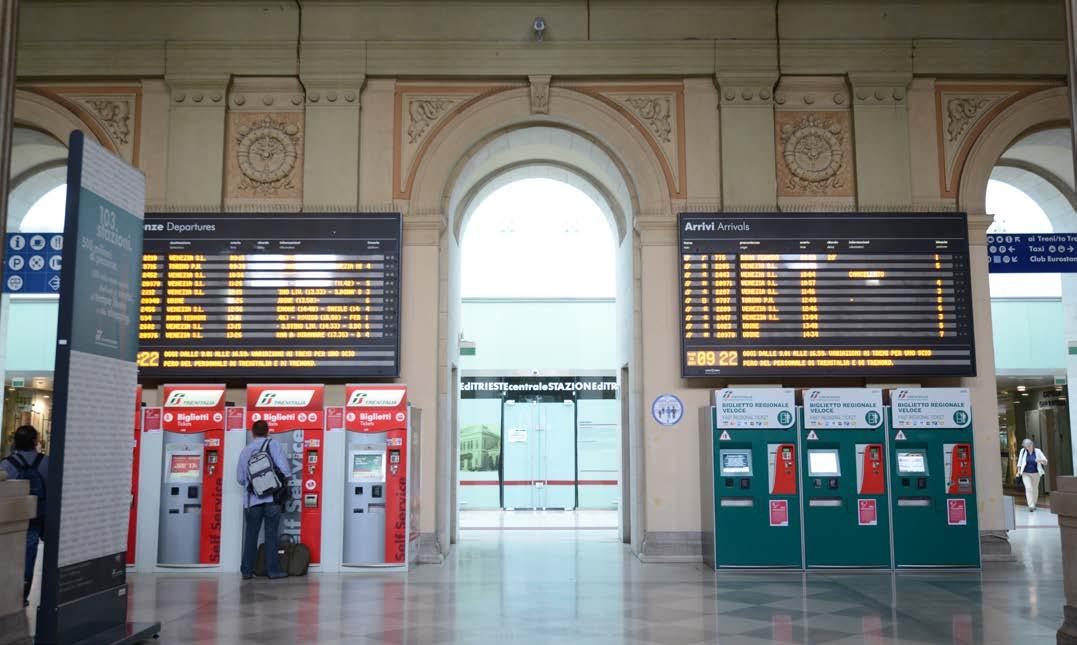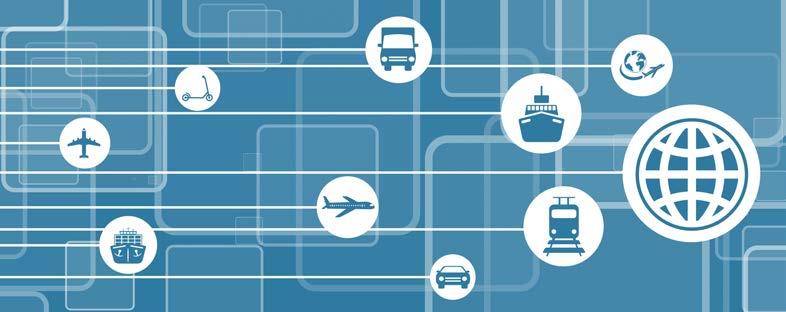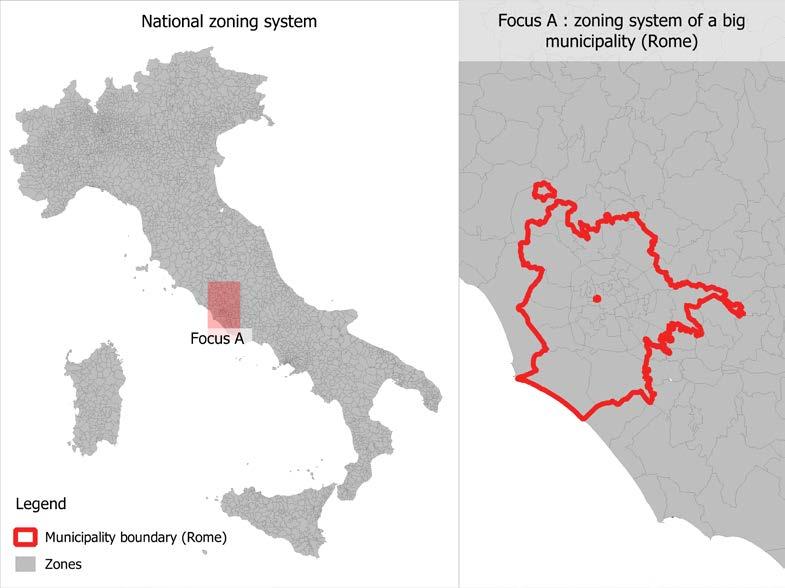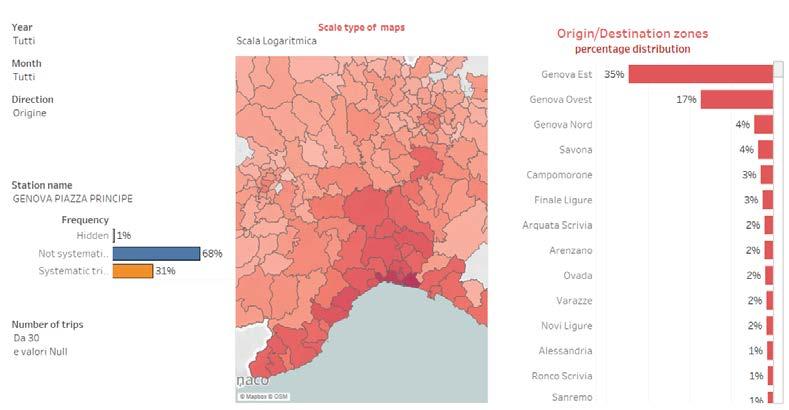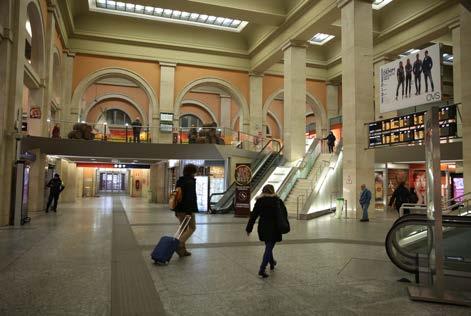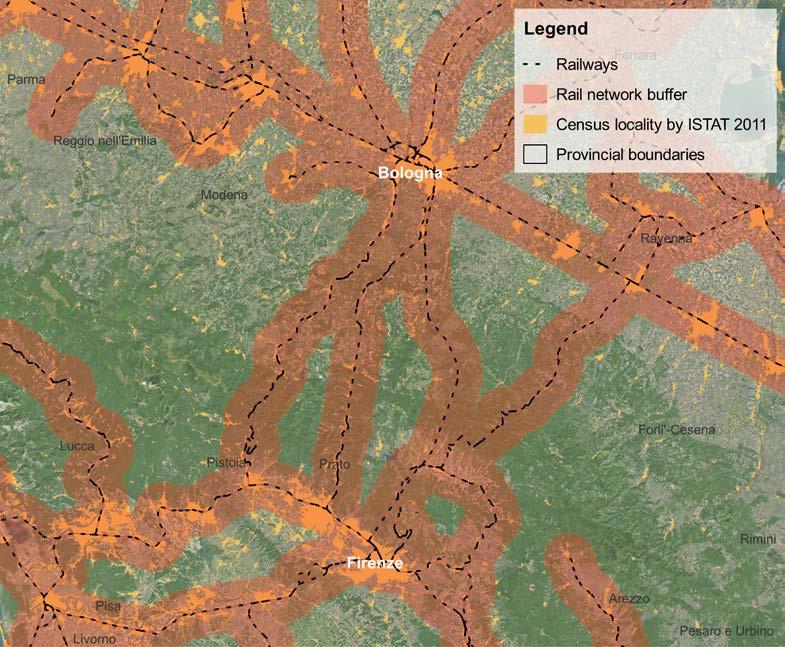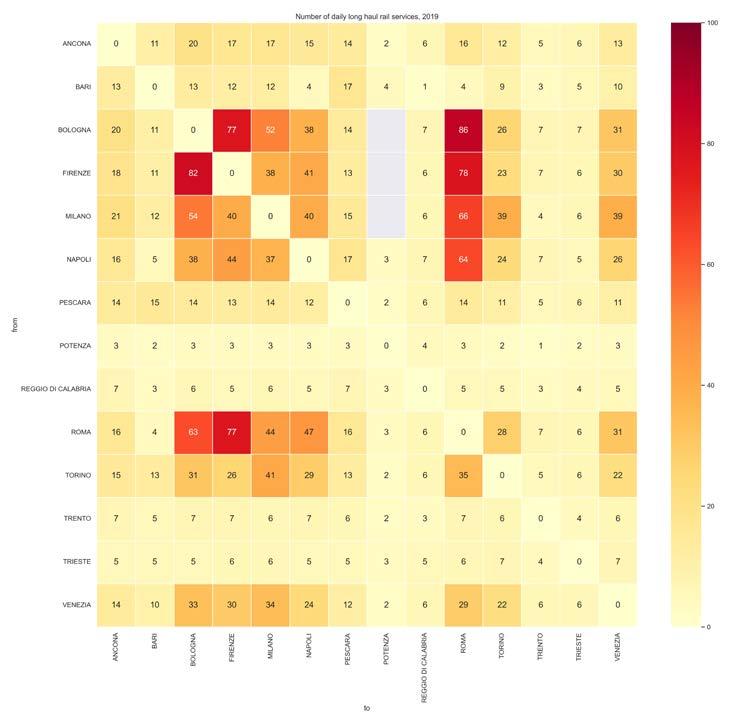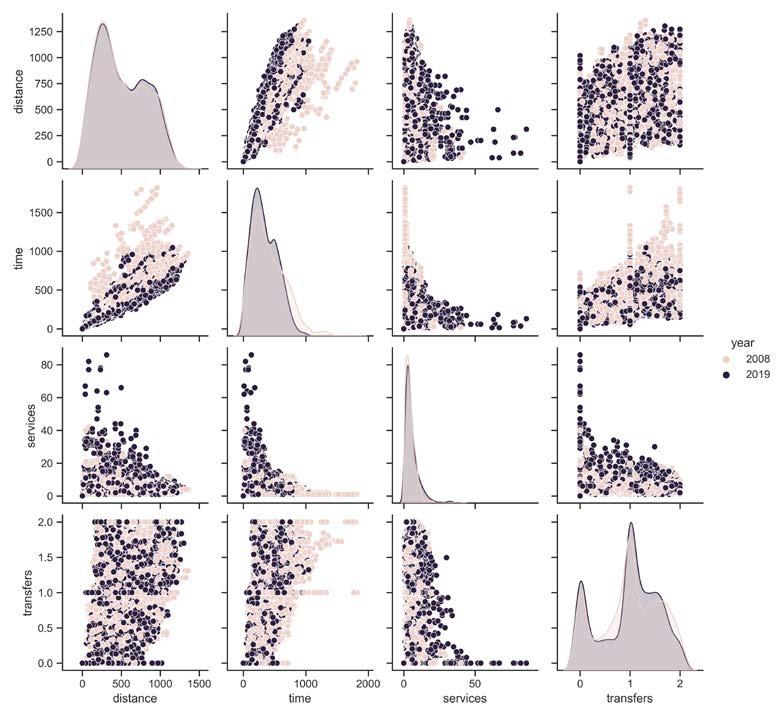
TECHNICAL PAPERS
METHODOLOGICAL ASPECTS FOR PASSENGER MOBILITY ANALYSIS USING BIG DATA
Technical Papers are monographic publications with scientific content, which explore issues related to the transport and mobility sector, from the point of view of the technical, environmental, economic, planning and modelling, taking into account the Interaction with innovative technologies. The authors belong to FS Research Centre, the in-house high-competence centre of FS Group for the development of studies and research on mobility themes, with a particular focus on sustainability and climate change, green transformation and decarbonisation of transport, Big Data and the Internet of Things, innovative transport systems, sharing economy, socio-economic and environmental impacts of transport systems, governance, ethics and fairness of mobility. FS Research Centre consists of a team of experts in mobility, transport, economy, environment, territory, data intelligence, geographic information systems and innovative technologies, which develop and use innovative mathematical models and data analysis systems. Publications are often written in collaboration with universities and other research institutes, institutions and public and private actors, both national and international.
ISBN: 978-88-940638-8-2
Ferrovie dello Stato Italiane SpA Piazza della Croce Rossa, 1 – 00161 Roma www.fsitaliane.it
All rights are reserved. No part of this publication can be reproduced, archived, translated, stored or transmitted in any form or by any means – electronic, mechanical, reprographic, digital – other than in the terms provided by the law that protects Copyright.
Edited by: Gruppo Ferrovie dello Stato Italiane IstatMinistero delle Infrastrutture e dei Trasporti
Photos
© FS Italiane Archive
© Adobe Stock (1, 11, 16, 25, 28-29, 30, 32, 48-49, 58-59, 60, 61, 62, 70, 72, 75, 76, 82, 93, 122)
2024 March
Opinions expressed are purely those of the authors and can’t be considered as an official position of FS Italiane, the Ministry of Infrastructure and Transport and Istat.
METHODOLOGICAL ASPECTS FOR PASSENGER MOBILITY ANALYSIS USING BIG DATA
1 | INTRODUCTION
1.1 Summary of contents
1.2 Bibliography
2 | DEFINITIONS
2.1 Types of indicators and reference infrastructures for data collection
2.2 Definition of Big Data
3 | GUIDELINES AND REFERENCE STANDARDS FOR MOBILITY DATA COLLECTION
3.1 Regulations for passenger transport statistics by mode of transport
3.2 Regulatory references for the production of indicators on mobility behaviour
3.3 Overview of the regulations for passenger mobility statistics on, with reference to statistical production.
4 | MOBILITY DATA SOURCES IN ITALY
4.1 Data from surveys, from administrative sources and other sources
4.2 Complementary sources to complete the knowledge framework
4.3 Reference sources for infrastructure and service representation
4.5 Summary of the main statistical surveys
5 | ANALYSIS OF SEVERAL CASE STUDIES ON PASSENGER MOBILITY
5.1 Analysis of the limitations of the current data sources for passenger mobility
5.2 Improving the information potential of traditional surveys through the use of Big Data
5.3 Bibliography


8.1 Formats and tools for storing, managing, and analysing Big Data 8.2 Big Data analysis and use for forecasting phenomena of interest 8.3 Use and future prospects of Big Data and Machine Learning in the field of transport
Mario Tartaglia 1 [0000-0003-3216-8150]
1. FS Research Centre, Florence, Italy
This paper is part of a project that arose in response to the institutional decision-makers’ and the industrial sector’s need for knowledge regarding certain aspects of mobility that are not yet comprehensively covered by the available statistical sources, official or otherwise, and the consequent demand for greater timeliness and continuity of information.
The current historical era, in which this analysis takes place, is referred to by some as the “Fourth Industrial Revolution”[1.1] : an ever-increasing number of people’s daily activities (travel planning, shopping, economic transactions, etc.) are being swallowed up by the “sea” of the digital world, which, in return, emits “waves” consisting of enormous quantities of data. These data have such large volumes and such distinctive features that a new term has been coined to describe them: “Big Data.” They are also characterised by specific properties, the main ones set out below will be explained in greater detail in chapter 2 “Definitions ”:
• Volume - referring to the amount of data.
• Velocity - speed of production.
• Variety - different types of data formats stored (photo, video, json, geo-json, etc. ).
• Veracity - a great uncertainty, because we do not really know the sample from which these data are extracted.
• Value - meaning the potential yet extremely important information value.
• Variability - the variability of even the form of the data, which creates considerable computer problems.
In the analysis of phenomena, therefore, traditional, structured surveys that produce “primary” data are increasingly being flanked by so-called “secondary” data, often originating from Big Data. However, it is important to note that Big Data exists regardless of the scientific questions that are sought to be answered
through its use, and it is often the secondary result of other activities. For instance, within the context of mobility, the information that can be collected from mobile devices is derived from their interaction with antennas and GPS systems for the ultimate purpose of making calls or exchanging messages and/or data, and not for the purpose of tracking people’s movements to investigate their mobility habits. Using human evolution as a metaphor, where human beings went from a nomadic lifestyle, out of the need to hunt and search for food, to a sedentary lifestyle, with the introduction of animal husbandry and agriculture, in the field of data the reverse process is occurring. In fact, while a “cultivator” of information sows the data he then wants to harvest, and therefore plans and structures the survey based on the type of information desired, with the use of Big Data the individual wanders in search of information where he thinks he might be able to find and extract it. In some ways, the use of Big Data for statistical purposes is similar to a recycling and reuse process. The other main difference between Big Data and traditional surveys is that the latter focus on the cause-and-effect relationships present in the phenomena they are investigating, whereas the former analyse the phenomenological aspects (i.e. the kinematic aspects, as far as mobility is concerned), or rather the ways in which they happen, and not the reasons. In short, as shown in Figure 1, Big Data has great potential in terms of providing large volumes of information, but actually has less potential in terms of depth of knowledge. Data obtained from traditional surveys, also known as “small data”, or “thick data” if they are predominantly qualitative, are able to provide more meaningful answers precisely because they are collected based on a plan which is determined by a specific need for knowledge.

Depth of knowledge
For the purposes of mobility analysis, it is therefore necessary to reflect on how Big Data can be used and how it can be integrated with existing data collection campaigns, and that is where this study comes in.
The goal of the project is to establish and validate a strategy that uses IOT data and Big Data to fill in the information gaps regarding people’s movements within different territorial areas, providing descriptions for each of them:
• the limit of the data’s applicability;
• the quality and reliability of the estimate;
• the definitions to be adopted to identify the characteristics of each domain;
• the representativeness indicators of an O/D matrix of journeys by domain. The study places particular focus on passenger mobility, identifying and expanding upon the main instances reported in the international reference documents, with a disaggregated
territorial focus. Ideally, the work presented here will lead to the establishment and validation of a methodological document, even through the development of prototype elements aimed at creating mobility indicators for people, obtained from IOT/Big Data sources, with particular regard to Mobile Network Data (MND).
The first section of this paper is dedicated to the formal adoption of the definitions of mobility as a pivotal element of the phenomena to be investigated in order to obtain the information needed on the topic (reference population, recurrent mobility, mode of transport, motivation, domains of interest, classification by distance classes, etc.), with reference being made to both the Eurostat Guidelines on Passenger Mobility Statistics1 and to the entire body of statistical information aimed at providing a representation of mobility to the
1. https://ec.europa.eu/eurostat/documents/29567/3217334/Guidelines_on_Passenger_Mobility_Statistics+%282018_edition%29.pdf/f15955e3-d7b4-353b-7530-34c6c94d2ec1?t=1611654879518
main users. After the regulatory analysis, the paper then delves into the description of the surveys, with a focus on the output indicators regarding mobility; the differences in the information produced by the various surveys are analysed, and the limitations for which the use of Big Data is sought as a solution are highlighted. The next step regards the determination of the Big Data production and quality control process, starting with the relevant best
1.1 | SUMMARY OF CONTENTS
The main topics covered in the chapters that make up the paper are summarised below.
• Chapter 2: Definitions
There are various types of variables and indicators used to represent mobility, depending on the perspective from which the phenomenon is observed. The traditional sources include activity indicators by mode of transport (of consistency, flow, traffic and performance), those related to the supply and demand of services (equipment, supply and demand levels, quality and satisfaction), and, finally, data regarding individual behaviour and choices (length and duration of journeys, origin/destination, motivations, and modal split). These can be flanked by “new sources”, the so-called Big Data, which arise for purposes other than the statistical representation of phenomena, and whose specific characteristics require them to be processed for statistical purposes using specific techniques, technologies, and professional skills. For both types of sources, it is also necessary to take into account the relevant infrastructures that generate them, based on which the data themselves are encoded.
Chapter 2 therefore contains the main indicators used to represent the phenomenon of mobility and the relevant infrastructures; it in-
practices and guidelines. The potential and limitations of Big Data, namely mobile phone data, are therefore illustrated, with applied examples in which the authors are involved. The applicability limits of the individual data types are clarified at this stage. Finally, a brief review is conducted of the Big Data processing techniques in relation to the increasingly interesting topic of Machine Learning.
troduces certain concepts relating to the world of Big Data, and briefly describes the types of Big Data that can be used within the context of mobility analyses.
• Chapter 3: Guidelines and reference standards for mobility data collection
In Italy, the reference standards for the statistical production of data on passenger mobility are based on a “mode of transport” approach, with a major gap being represented by the absence of standards for road passenger transport statistics; there is also no national regulatory reference for the statistical representation of mobility behaviour. The legislation determining the production of statistics by mode of transport is mainly established at the EU level in the form of Regulations or Directives, which are then transposed by the Italian legislative system. A number of European and Italian guidelines have been developed that are either directly or indirectly related to the production of mobility indicators.
Chapter 3 illustrates the main guidelines, regulations and standards applicable at the European and national levels. Regulatory references are also provided for activities involving the collection of mobility data regulated by guidelines or by law.
• Chapter 4: Mobility data sources in Italy
Passenger mobility statistics are derived from numerous sources, which can be classified with respect to both their methodological characteristics and their information potential, thus determining whether they are considered “official statistics”, and the types of indicators comprising them, thus determining the perspective from which they represent the phenomenon. We therefore have a diverse set of processes, definitions and insights, which provide an extensive though not comprehensive description of mobility. Moreover, the available sources often respond to information and regulatory needs (see Chapter
3 “Guidelines and reference standards for mobility data collection”) of a different and non-overlapping nature. In addition, in order to produce complex and meaningful outputs, the surveys require considerable investments to be made in terms of resources to be used in a sustainable manner over time. For these reasons, obtaining an organic and comprehensive representation of the phenomenon in question is an important goal to strive for, for which the use of Big Data would certainly be an added value.
This chapter describes the mobility data sources, grouped by survey type (mobility behaviour, supply and demand, and mode of transport). A number of complementary sourc-

es useful for establishing transport models and/or evaluating national and international strategies are also identified.
• Chapter 5: Analysis of several case studies on passenger mobility
The available data sources on mobility in Italy create a jagged and multi-faceted picture; on the one hand we have large amounts of data linked to specific sectors, while on the other hand we have comprehensive mobility surveys carried out on small samples. The first group includes data from transport service operators and infrastructure managers, such as railway ticketing data, and motorway and airport data; much of the data fails to overlap with that from other sectors, and only provides insight into mobility with respect to the organisation of that specific transport infrastructure. For example, when the former elements are considered for determining transport demand, and the generation and distribution of travel throughout the territory, the origins and destinations coincide with notable points of the infrastructure, such as train stations, motorway barriers and airports, and thus only provide a partial view of the origins/destinations of the journeys. Surveys such as the ISTAT census and the Isfort Audimob survey, on the other hand, provide very precise information on the origins and destinations of travel, but only on a partial sample of the population, because they are limited with respect to either the purpose of the journey, whether work or school, or with respect to the number of people interviewed.
Chapter 5 describes several limitations of the available data, and identifies a number of possible solutions from the perspective of technical/economic sustainability, examining some of the new prospects introduced by the use of Big Data.
• Chapter 6: The Big Data lifecycle
Due to the characteristics of the data and the processes that generate them, the Big
Data lifecycle requires the establishment of a dedicated pipeline, with entirely new process steps with respect to the traditional statistical processes involving estimates and indicators, such as those carried out on data from surveys or administrative sources. For instance, surveys are designed to meet specific knowledge needs, while administrative sources are selected based on how well they describe the phenomenon in question.
The approach to the use of Big Data requires the introduction of preliminary analysis stages, not only for their selection, but above all for the establishment of new processing methodologies. The use of these data requires personnel with specific skills in analysing large volumes of data, which are high variable and have an intrinsic information value that requires various kinds of technical knowledge in order to be managed. When combined with aspects like data access and privacy, these characteristics make it necessary to implement specific organisational measures, not only with regard to the entire data lifecycle process, but also with regard to the personnel, and the relationships with the suppliers, which are often external to the data user. In particular, the analysis of this type of data requires the introduction of innovative professional figures, such as data scientists, as well as dedicated Software and Hardware architectures. In general, one must be aware that the use of Big Data requires considerable investments, not only in terms of technical capabilities, but above all in terms of the acquisition of knowledge and qualified human resources.
Chapter 6 describes various proposals for standardising the Big Data handling process, starting with the European experience of the ESSnet Big Data project, and goes on to provide the proposed approaches to privacy protection.
• Chapter 7: Extraction of information
This chapter describes the experience gained in interacting with a telephone service pro-
vider and the relative analysis company in order to acquire and use telephone Big Data to conduct mobility analyses throughout Italy.
The processes described were carried out by Ferrovie dello Stato Italiane Group’s FS Research Centre and Trenitalia Strategy Department, with the support of Vodafone Business and Motion Analytica, using the Vodafone Analytics generated by the Vodafone network (non-personal, anonymised and aggregated telephone Big Data, in full compliance with the GDPR privacy requirements). The first part describes the technical characteristics of the data utilised, and goes on to describe some of the processing operations carried out with the telephone Big Data, highlighting the critical issues encountered in dealing with these new types of data, including those which were resolved and those which remain open.
• Chapter 8: Analysis and modelling
Large amounts of data, in numbers far exceeding those of the samples used for traditional surveys, require new tools and techniques for the representation and extraction of the information, and for the use of that information for conducting analyses and forecasting in the field of transport.
In recent years, the increased interest in Big Data has been accompanied by exciting studies and tools related to artificial intelligence. The main use of Machine Learning in the field of Big Data is for the interpretation and analysis of the large amounts of information con-
1.2 | BIBLIOGRAPHY
tained therein. The other area of development between Big Data and Machine Learning is its application in the field of transport modelling for forecasting purposes; once “trained”, in fact, Machine Learning algorithms make it possible to predict the variables of interest whenever the initial input changes. The implementation and training of these algorithms requires a lot of data, and this need seems to be met by the “volume” characteristic of Big Data. Despite the consensus regarding the need to develop “models” based on Machine Learning and the potential offered by Big Data, the application of Big Data in the field of transport modelling raises certain doubts regarding the replacement of traditional approaches. These doubts regard the new techniques’ ability to reproduce the discretionary nature of user choice, and, above all, the lack of clarity surrounding the model’s functionality; in fact, unlike the traditional theoretical/ experimental approach, in which the laws governing the models are known, with this new system the model consists of a black box, which responds to inputs according to a logic that is not known to the user.
Chapter 8 discusses the main artificial intelligence techniques that arose in the 2000s, their possible applications in conjunction with Big Data in the field of transport, and the benefits and main limitations associated with the new techniques. Due to the speed at which the subject matter changes, the examples provided cannot be considered exhaustive.
2 | DEFINITIONS
Giovanna Astori 1 1. ISTAT, Rome, Italy2.1 | TYPES OF INDICATORS AND REFERENCE INFRASTRUCTURES FOR DATA COLLECTION
2.1.1 | TYPES OF INDICATORS FOR REPRESENTING PASSENGER MOBILITY
The phenomenon of passenger mobility is complex and multi-faceted, as it is an important part of every country’s socio-economic fabric, and depends on it at the same time. For this reason, its qualitative-quantitative representation in the fields of research and statistics is also far from linear, having numerous aspects and perspectives, which we will attempt to outline below, highlighting its characteristics, even with regard to the relevant definitions and variables.
Generally speaking, there are four main perspectives in the field of national and international statistics, within the context of which mobility and certain other related phenomena must be represented in support of public and private activities and for the benefit of the community.
a. Representation of the activity and the performance with regard to the companies and infrastructures throughout the country, by mode of transport. This category includes a number of cases:
- consistency/point and flow data: number of passengers (e.g. number of passengers embarked/disembarked per port or airport; number of passengers transported per air route; number of passengers transported per mode and type of flow: national/international EU/Extra EU/ Total);
- traffic data: Vehicle-kilometres (Vkm), which represent the total number of kilometres travelled by different vehicle categories over a reference time period, and within
a defined territorial area (e.g: Total km travelled by passenger cars in Italy over a year; Total km travelled by light vehicles on extra-urban roads over a month, total km travelled by vehicle type, age, and fuel type). Number of vehicles that transited within a territorial area over a period of time (e.g. number of light vehicles transited on the A1 motorway in a month, average number of vehicles/day on road X between the hours of y1-y2, etc.);
- performance data: Passenger-kilometres (Pkm), which represent the total number of kilometres travelled by all passengers by mode of transport, and in relation to a defined territorial area and time frame. These coincide with the Vkm value in the case of a one-to-one correspondence between vehicle and passenger. The Pkm value is generally equal to the sum of the (individual) kms travelled for all the occupants of the vehicle. (e.g.: Passenger-kilometres travelled by rail within a region, during the quarter; Passenger-kilometres travelled within Italy, by private cars, in urban areas, during the reference year).
- The data in this category are generally collected in census form (with the possible application of thresholds or limitations to the field of observation, e.g. with regard to the ‘size’ of the enterprises involved, or other parameters), or through survey points located throughout the country, or else are derived from the processing of data obtained from public or private
administrative registers. In most cases, these data are not obtained from surveys involving random samples of the reference statistical units.
b. Representation of the level/status of the infrastructure, of the service supply, and of their use and satisfaction. This perspective defines the phenomenon from the standpoint of the potential of the infrastructure and that of the supply/demand and the service planning, as well as from the standpoint of the citizens’ assessment of the quality of the services. These are quantitative and qualitative data, even of an administrative nature, and are related to the establishment of Urban Traffic Plans (UTPs), Urban Mobility Plans (UMPs), and Sustainable Urban Mobility Plans (SUMPs) at the local government level. This group includes:
- Existing infrastructure: the number of infrastructures present within a territorial area (e.g. ports, airports, train stations, fixed installations, funicular railways, cycle paths, electric vehicle charging points, LTZs, public car parks and park-and-rides, installed bicycle racks, road inventory, etc.). Qualitative-quantitative characteristics of the infrastructures present (e.g. length of the rail network, size of the port quays, existing inter-modal connections, port terminal equipment, equipment and characteristics of motorway service areas, etc.);
- Supply: level of mobility supply by type/ mode of transport (e.g. number of ride share vehicles available, number of trains, seats offered for LPT, number of LPT journeys, number of taxi licences, etc.);
- Potential and actual demand: (potential) ticket and pass data (e.g. number of LPT passes by type, train tickets sold, etc.): these express the potential impact of the mobility demand on the territorial area, but do not provide a measure of the transport system’s actual use. (actual)
data on the use of the transport system (e.g. number and territorial reference of authenticated tickets/passes, motorway toll sales, mileage travelled with shared vehicles, etc.);
- Quality and satisfaction level: satisfaction indices and indicators for the various aspects of the mobility services offered (e.g. for the use of LPT, ride share services, high-speed rail, etc.).
c. Representation of the mobility behaviour, journeys, and travels carried out by the population. This is a ‘subjective’ perspective, which describes and quantifies the mobility behaviour of the reference population, the modal choices, the purposes of the journeys, and the structure of the journeys themselves, even with regard to time domains (i.e. business days or holidays) and spatial domains (urban/non-urban, national/international). One of the characteristic features of this representation lies in the possibility of relating mobility behaviour to the socio-demographic characteristics of groups of individuals, which define the reference domains of the sets of indicators. The main reference variables/ indicators are as follows:
- Temporal: duration of the travel (e.g. average travel time in urban areas and on weekdays, per person/day);
- Spatial: length of travel (e.g. average distance travelled per person/day, average length of travel by purpose, etc.);
- Frequency/consistency: numerosity (e.g. average number of journeys per person/ day, average number of journeys per person/year, number of journeys per distance class with and without overnight stays, distribution of journeys by time slot, vehicle occupancy rate). Passenger-km: unlike that listed in case a), here this indicator is represented according to different types of domains (gender, purpose, age, etc.), as indicated in the introduction;
- Flow: Origin/Destination matrices (num-
ber of people who habitually move from origins O1, O2, ...On, to destinations D1, D2, ...Dm; commuting matrices, etc.).
d. Representation of mobility-related phenomena. This case includes indicators and variables that contribute to further broadening and characterising the representative picture of people’s movements, or are influenced by the same. The main ones include a number of research and statistics issues:
- Tourism;
- Road accidents;
- Accessibility: experimental studies and models to measure the accessibility of places of interest, of particular importance in urban areas, also related to SDG Area
11. (e.g. share of the population living within a specific distance from places of public interest – e.g. schools, LPT stops, train stations, etc. That distance is generally defined in terms of the duration of travel on foot, or by a specific mode of transport; in this case we’re talking about accessibility for that mode, e.g. bicycle);
- Quantification of the incident population, or rather the population that, for whatever reason, has a relevant ‘impact’ i.e. moves from, to and within a given territory;
- Quantification of the atmospheric emissions of the means of transport;
- Turnover indices, economic results, investments of companies in the passenger transport sector.
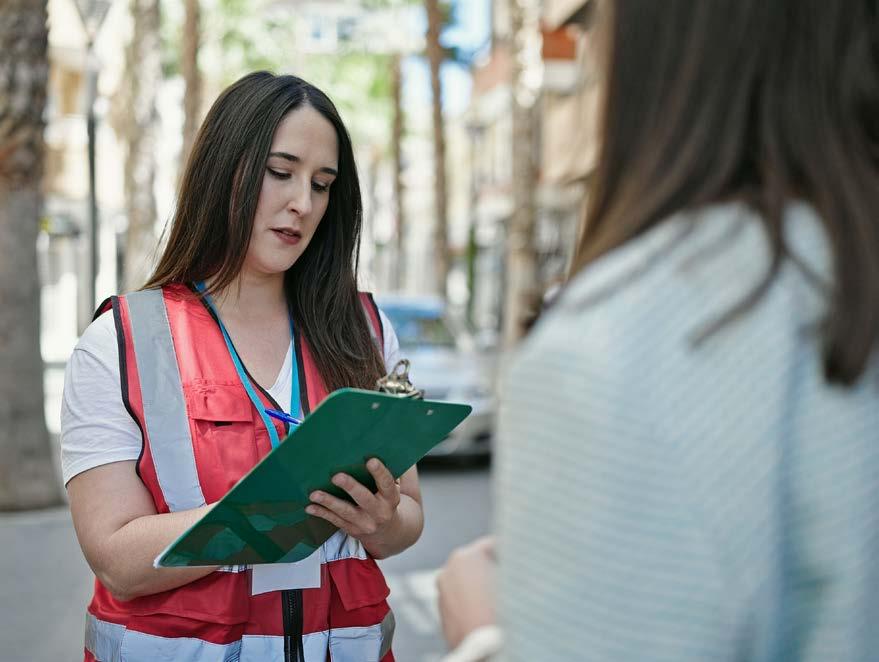
2.1.2 | INFRASTRUCTURE AND REFERENCES FOR DATA ACQUISITION AND THE CREATION OF MOBILITY INDICATORS
In order to have a framework for the formal adoption of methodologies for creating mobility indicators that’s both theoretical and operational, it is useful to highlight the characteristics of the infrastructural and decision-making system within which the data are collected. Whether from an administrative source or from a statistical survey, the indicators generated or of interest refer to entities of a territorial, infrastructural or economic nature, both from that standpoint of observation and that of subsequent summary representation. Some of these are indicated below:
- Ports; airports; train stations; bus stations;
- Administrative/territorial units (Countries; Regions; Departments; Provinces/Metropolitan Cities; Municipalities; etc.);
- Trunk roads/highways; Motorways; Rail-
2.2 | DEFINITION OF BIG DATA
The concept of “Big Data” is closely linked to the evolution of technology, the massive use and spread of electronic devices that has created the so-called “Internet of Things” (IoT), and the dematerialisation of economic and financial transactions and many everyday activities (online shopping, social interaction, smart working, travel planning, etc.). They are the ‘digital footprints’ that we continuously leave in the system in which we live and operate. There are several defining paradigms in the literature that have sought to give an identity to the concept of Big Data (BD), which essentially consists of massive and persistent streams of data generated for different purposes. The most comprehensive definition is that of the “6V model.” According to this definition, Big Data consists of structured or unstructured information generated by devices, social media, digital platforms, and/or computer systems, charac-
way infrastructures by type;
- Companies/service providers;
- Resident population. It is also worth bearing in mind that the domains within which the indicators are to be calculated take additional classifications and reference entities of the following nature into account:
- Territorial: Functional Urban Areas, distance classes, urban/non-urban area, etc.;
- Modal: mode of transport, prevailing mode of transport;
- Temporal: weekday/holiday, time slots, recurrent mobility, habitual mobility, etc.;
- Socio-economic: gender, age, residence, etc.;
- Other attributes: vehicle age, vehicle fuel type, etc.
terised by the following:
- Volume: the amount of data generated is such that it cannot be handled, manipulated, or processed using common IT systems;
- Variety: the data consist of various types (structured, e.g. according to a layout; semi-structured, with coded and unstructured parts; unstructured, e.g. signals generated by systems, servers, etc.);
- Velocity: data are generated at high velocity, like a continuous flow;
- Veracity: data do not always guarantee reliability in terms of interpretation and translation into information useful for representing other phenomena;
- Value: data potential information generate an economic value;
- Variability: the consistency and coherence of the data flows over time is not
guaranteed in terms of representativeness. For statistical research purposes, especially in the area of mobility, the points of contact between these massive data flows and the physical network of movements carried out by the population are useful for assessing whether
they can be used to represent mobility through indicators and models. It is also essential to develop tools, procedures, and methodologies aimed at manipulating and transforming the mass of raw information, in order to render it suitable for statistical and forecasting purposes.
2.2.1 | TYPES OF BIG DATA POTENTIALLY SUITABLE FOR REPRESENTING PASSENGER MOBILITY
As indicated by the definition provided in the previous section, Big Data is generated by numerous types of sources, each of which gives rise to completely different types of data with different drawbacks and advantages, which may or may not lend themselves to representing passenger mobility. Here we will highlight the main types of Big Data that can be further analysed for this purpose, with the focus being placed on their connections with some of the main indicators of interest, both in terms of affinity and divergence. The second part of this paper will discuss case studies involving mobile data in particular.
a. Mobile Network Data (MND) or Mobile Phone Data (MPD) There are two types: the first consists of the sequences exchanged at very close frequencies between the SIM cards inserted into the devices and the antennas that spread the signal, which are generated regardless of the occurrence of active events, such as calls, messages, or Internet connections. The second type, on the other hand, consists of the set of SIM-related data generated by the occurrence of those events. Signal data have the advantage of being very frequent, and thus allow the movements of individuals to be tracked more continuously, but are less precise in terms of localisation (due to the technical specifications and the positioning of antennas and cells associated with them); the event-generated data, on the other hand, although less frequent, allow for more precise localisation. Signal data are
generally used in case studies. In general, given the widespread dissemination of mobile telephone services, MND guarantee broad coverage of the population, but their nature and informative power must be analysed in depth in order to prevent their use from leading to a representation of the phenomenon that does not always correspond to reality. This type of data is generally used to extract the following types of information sets: user identifier (anonymised); signal time reference; antenna/hook cell identifier. It is important to bear in mind that some protocols re-establish user anonymisation at high frequency (even every two hours), which makes it impossible to identify mobility behaviour over longer time horizons.
b. Global Positioning System (GPS) data are generated by systems that record the positioning of devices via networks of satellites orbiting the Earth. They contain information on the positioning of mobile devices (Smartphones, Smartwatches, devices installed on vehicles for monitoring or navigation purposes, etc.), which are collected through the Apps installed on them. Unlike MND, they also contain the geographical coordinates of the places visited. Depending on the options selected by the user, they can track movements all the time, only when the relative App is in use, or else can be deactivated entirely (the latter option generally does not allow for the proper use of the App or inhibits it altogether, and is therefore a residual
option). The collection and processing of data from multiple apps or devices for the same user also allows for a more accurate representation of the movements carried out, with any missing information being filled in by one or more sources. Some of these sources, which record the history and structure of the movements carried out by the person carrying the device (Google Live Traffic, Apple maps, Waze, etc.) are particularly useful for representing mobility from an objective (e.g. traffic congestion) and subjective perspective (e.g. routes most frequently used within a defined territorial area; the algorithms also manage to identify the vehicle used and the places visited with a good level of precision). However, they have certain critical issues, including difficulty in identifying the actual user of the device (multiple accounts on the same device or the same account on several devices can generate overlaps and errors), the possibility for users to deactivate them or to change the routes taken, and, last but not least, difficulties in accessing the data, as they are privately owned.
c. Social network data is information that users voluntarily enter into their social media profiles (Instagram, Twitter, Facebook, WhatsApp, Google, etc.) when describing or recounting information about the activities they perform throughout the day, recording their presence at the virtual places corresponding to the physical places where they perform those activities. While these data are discontinuous, and subject to a margin of error or approximation, they can be useful for verifying mobility events derived from other sources. For this type of data, particular care must be taken to protect confidentiality when accessing the relative information.
d. Floating car data (FCD) is information generated by satellite tracking systems and collected by ‘black boxes’ (OBUs – On Board Units) installed on the latest
generation of vehicles, even for insurance purposes. They are mainly used to quantify traffic, but can also be used for the representation of route data. The information they contain is related to the georeferencing of the movements, time references, speed of travel, etc. This type of data can be used in synergy with traffic and transit data acquired with the implementation and use of “Smart road” systems (V2Icommunication between infrastructure and vehicle - and V2V - communication between vehicles), which envisage the installation of various types of sensors (loops for detecting the passage of vehicles, cameras for automatic plate recognition, sensors communicating with vehicles, etc.) along sections of roadway, with the aim of optimising traffic and routes through digital communication with and between passing vehicles, thus increasing safety levels and promoting the use of self-driving vehicles. The information contained in “smart road” data involves the detection of numerous variables, including: geo-referencing of observation points, vehicle type, distance between vehicles, speed, exact time reference, and reference to detected lanes/roads and direction of travel, with continuous detection and transmission to the data hub at intervals of just a few minutes. The vehicle trip data (recording of an ‘entry’ and ‘exit’ event on the road for the same vehicle, identified and anonymised) are of a sampling type, and can be associated with the reference population, which consists of all the vehicles ‘recorded’ by the sensors on the road section in question.
e. Shared mobility data consists of data acquired from fleets of shared vehicles (cars, motorcycles, scooters, ebikes, etc.). They provide information about the vehicles’ locations at the origin and destination of their journeys (even in relation to interchanges, such as railway and LPT stations), the mileage travelled, and the
travel times. The data can be correlated to the socio-economic characteristics of the user. They can be used to generate a representation of the use of different modes of transport in urban areas and the inter-modal choices.
f. Smart card data is information acquired through the use of electronic cards (with built-in RFID, NFC, etc. technologies), which communicate via radio waves with fixed devices used to access various types of places. These devices include electronic passes for local public transport, and cards that combine LPT access with admission to other places of interest (museums, etc.), which are generally used by tourists and visitors. These devices therefore record a wealth of very detailed information about the individual, the places visited, and the means of transport utilised. One limitation in their use for the purpose of representing individual mobility behaviour lies in the fact that, in many cases, they make it possible to record access to or use of a vehicle, but not its trajectory (entry and exit).
g. Points of interest data (POI) are derived from Apps and databases (e.g. Google places) that identify places at specific geographical coordinates classified based on their attributes (e.g. schools, museums, offices, ministries, entertainment venues, shopping centres, etc.). Therefore, when combined with other data sources, such as mobile phone data, this information makes it possible to identify the purposes of the travel, and therefore the motivations for the mobility, with a certain degree of approximation.
h. Land-use data are generally satellite images from which information of various kinds can be derived, which can be used to feed into models for describing and predicting passenger mobility, or to represent related phenomena. One area in which they are used is for accessibility studies. Another type of data that falls under this category are spatial representations created using collaborative systems, in which users voluntarily contribute to defining the structure of the territory and the infrastructure located therein, using applications like the Open Street Map project.
i. Automatic Identification System data (AIS). AIS systems are based on GPS technology and radio channels, and allow for the positioning, and therefore the trajectories, of ships to be determined. AIS data are used for numerous applications to generate statistics, especially maritime traffic and accidents, as well as to estimate emissions. These consist of character sequences that require pre-processing for filtering and decoding in order to be used for statistical purposes. One of the most critical issues lies in the availability of the data, which are held by several public and private entities, thus limiting their accessibility.

2.2.2 | INFRASTRUCTURE AND BIG DATA REFERENCES FOR MOBILITY
In order to identify the points of contact and divergence between the spatial/temporal and conceptual references with which ‘traditional’ data are observed and statistical indicators on passenger mobility, and those related to Big Data that could be used for the same purpose, and produced, a brief examination of some of the latter is useful, as was done in section 2.1.2 for traditional data and indicators.
- Data acquired through personal mobile devices (SIM cards, smartphones, smartwatches, cards, etc.) refer to accounts or account holders, without any certainty that the account holder corresponds to the user of the device. While this correspondence is more likely in some cases (smart cards), it can be all but excluded in other cases, such as corporate Sim cards. This makes it problematic, for example, to relate the data collected to the social/demographic characteristics of the person in movement;
- The data acquired through fixed sensors on the roadway (e.g. traffic counters, smart traffic lights, smart roads) are referenced to spatial entities that, with some difficulty, could be referenced to other geographical entities (e.g. the trunk road
associated with the province or region, if close to the borders);
- Mobile network data acquired with reference to antennas and their cells require complex probabilistic processing in order to be traced back to commonly used geographical or spatial references, especially in high-density areas where cells often overlap or are irregularly shaped.
- As illustrated in the previous section, there are different types of data acquired through sensors installed on vehicles. Floating car data provide information on the passage or trajectories of vehicles, but say nothing about their occupants. GPS coordinates, however, when available, directly refer to well-defined territorial areas (e.g. regions, municipalities), at least up to a certain point. The data associated with the counting of LPT passengers accessing a vehicle (boarding/deboarding counters, excluding smart card type data that require an action by the passenger) provide a measure of vehicle occupancy and passenger-km travelled, but not origin/destination trajectories, as the individual passengers are not identified.
3 | GUIDELINES AND REFERENCE STANDARDS FOR MOBILITY DATA COLLECTION
Giovanna Astori 1 , Giovanni Zacchi 2 , Francesca Sieli 2
1. ISTAT, Rome, Italy
2. MIT, General directorate for digitalisation, information and statistical systems, Rome, Italy
3.1 | REGULATIONS FOR PASSENGER TRANSPORT STATISTICS BY MODE OF TRANSPORT
The regulatory sources for statistics production by mode of transport in Europe and Italy are the following:
a. Regulations (EC) 437/2003 and 1358/2003 (Air Transport). The purpose of Regulation (EC) 437/2003 is to establish a sound statistical basis for the establishment of EU air transport policies. The need for comparable, consistent, synchronised, and regular statistical data regarding the levels and dynamics of passenger, freight and postal air transport has led to the determination of all the aspects necessary to produce standardised indicators. The aforementioned Regulation is supplemented by implementing regulation (EC) no. 1358/2003, which contains important methodological information, such as the airport categories subject to reporting obligations, as well as additional definitions, and coding guidelines. The shared collection of data on a comparable or harmonised basis allows for an integrated system that provides reliable, consistent, and timely information. Every EU country must collect statistical data on: passengers, cargo and mail, flights, seats available for passengers, and aircraft movements from all the airports within their territory that have more than 150,000 passenger units per year. Airports with 15,000 to 150,000 passenger units are required to collect less detailed statistics, while those with less than 15,000 passenger units are not required to collect statistics at all. In order to minimise the burden on the declarant, to the extent possible,
the collection of the data is based on readily available sources.
b. Directive no. 2009/42/EC of the European Parliament and of the Council; EU REGULATION no. 1090/2010 of the European Parliament and of the Council; EU REGULATION no. 1239/2019 (Maritime Transport).
In order to ensure a harmonised representation of the maritime transport phenomenon through statistical indicators, the European legislation (Directive 2009/42/EC and EU Regulation 1090/2010) provides for the implementation of a continuous survey of ship arrivals and departures from Italian ports, of goods loaded and unloaded, and of passengers transported. The reference population is the Italian ports, for each of which the ship arrivals and departures, and the embarkation and disembarkation of passengers (and goods), are observed and recorded. The data are collected from companies operating in the sector (shipping agents, shipowners, freight forwarders, etc.).
EU Regulation no. 1239/2019 introduces an interoperable European maritime single window environment (EMSWe) with harmonised interfaces, to simplify reporting obligations for ships arriving at, staying in, and departing from European Union (EU) ports. It aims to improve the European maritime transport sector’s competitiveness and efficiency by reducing administrative burden and introducing a simplified digital information system.
The EMSWe is the legal and technical frame -
work for the electronic transmission of information about reporting obligations for ships calling at EU ports. It is a network of maritime national single windows with harmonised reporting interfaces and includes data exchanges using SafeSeaNet and other systems, along with services for: user registry and access management; common addressing service; EMSWe ship database; common location database; common hazardous material database; ship sanitation database. The regulation maintains the existing maritime national single window in each EU Member State as the basis for a technologically neutral and interoperable EMSWe.
The European Commission is empowered to adopt delegated acts to establish a new common EMSWe dataset, incorporating and adapting the most relevant requirements in existing national or EU legislation, in order to harmonise the existing national systems and reduce the need for paper media.
c. EC Regulation no. 91/2003; EU Regulation no. 2032/2016; EU Regulation no. 643/2018 (Rail Transport)
EU Regulation no. 643/2018 recasts and replaces EC Regulation no. 91/2003 (as amended). It applies to all EU railways. It establishes common standards for the production of rail transport statistics at the EU level. Member states must provide statistics for all rail transport operations carried out within their territories, and break them down by country if the service is international. Companies may be excluded from the statistics if:
- they operate within industrial zones or ports;
- they provide local tourism services, such as historic steam trains.
The indicators are updated quarterly, annually, or every five years (see Chapter 4 below, entitled “Mobility data sources in Italy”). National information collected by a public or private body may come from: compulsory surveys; administrative or regulatory data; estimation
procedures for statistical purposes; professional organisations operating in the railway sector; specific studies. Eurostat develops and updates the harmonised methodology to ensure quality data. The Commission needs rail statistics to monitor and develop the common transport policy, including the trans-European networks, and to take action to improve rail transport safety. Common standards and concepts ensure that the national statistics are comparable and that duplications are avoided.
d. Other Italian sources
Finally, art. 3 of Italian Law no. 1085 of 1967 states:
“The Ministry of Transport and Civil Aviation shall be responsible for the preparation of a national transport survey, in which the expenditure incurred by the State, other public bodies, and private sector entities for the operation and investment in the areas under the purview of the Ministry of Transport and Civil Aviation, both globally and by individual means, shall be taken into account, for the purposes of determining transport policy directives, and in accordance with the indications of the national economic plan.”
Therefore, every year the Ministry of Infrastructure and Transport (MIT) publishes the National Infrastructure and Transport Survey (NITS), which, in addition to fulfilling the requirements of the aforementioned regulatory source, since its first editions has also contained an increasingly vast and as comprehensive as possible collection of additional indicators produced by multiple sources to illustrate the complex and multi-faceted transport and mobility sector.
3.2 | REGULATORY REFERENCES FOR THE PRODUCTION OF INDICATORS ON MOBILITY BEHAVIOUR
With regard to the production of harmonised indicators on mobility behaviour, the only recent methodological/procedural reference are the Eurostat guidelines on Passenger Mobility Statistics, which do not constitute a commitment on the part of the member states since, by definition, they are merely a system of indications aimed at guaranteeing an information framework that’s harmonised in terms of the quality and comparability of the indicators produced.
Another possible reference at the national level are the guidelines for the preparation of SUMPs (Sustainable Urban Mobility Plans). This document establishes both the strategic objectives to be met by the SUMPs, and the sets of indicators to be used for their evaluation, which include infrastructure and accessibility indicators, the organisation
of services and their levels of satisfaction, mobility supply and demand, and accidents. Unlike the Eurostat Guidelines, the objective here is not strictly related to the production of statistical information, so the methodological elements necessary to achieve that goal are not defined.
In addition, Interministerial Decree no. 179 of 12/5/2021, concerning the “Implementation of the provisions relating to the figure of the mobility manager” defines the information perimeter for the management and optimisation of mobility by company, school and area mobility managers for work purposes (and of school mobility, only on a voluntary basis), in order to reduce the use of private vehicles, with the establishment of Home-to-Work Travel Plans (HTWTs) and the guidelines for their preparation and monitoring.
3.2.1 | EUROSTAT GUIDELINES ON PASSENGER MOBILITY STATISTICS
The handbook is a thematic and methodological support, which examines all aspects useful for delineating the field of observation and ensuring the harmonised production of information on passenger mobility behaviour. It contains: the definitions agreed upon by the Member States to describe the aforementioned phenomena (concepts, variables, classifications, methodologies); the sets of reference indicators (of reference for the provision of estimates to Eurostat, even in relation to projects that can be financed with grant agreements, divided into ‘minimum’ reference indicators, meaning a basic outline of the breakdowns to be adopted in order to provide an overall representation of the phenomenon and ‘optimal’ reference indicators, with a more disaggregated detail of the modalities for certain estimation domains); the
quality parameters; the metadata and procedures used by the Member States already conducting the survey, including facsimiles of the questionnaires used for data collection. The Guidelines are structured along the lines of the mobility categories by distance. In particular, a distinction is drawn between journeys over short distances (‘local’ mobility), and journeys over medium to long distances. This approach identifies two phenomena in mobility behaviour that are complementary yet different, requiring a different definitional and methodological framework for proper measurement and interpretation.
Short-distance journeys (up to 300 km), which include the specific sub-domain of urban mobility, are generally daily journeys of brief duration (minutes, hours), carried out using several modes and for different reasons, and

have the ‘log’ as an elective survey instrument. Medium- to long-distance journeys, on the other hand, are less frequent, in part involve the use of modes of transport other than local transport (e.g. air), and may or may not involve overnight stays. The retrospective survey is the preferred survey technique for this mobility category.
The sets of indicators identified in the Guidelines are differentiated by these two mobility categories.
The categorisation criteria for the local mobility indicators are based on the “urban” and “non-urban” mobility paradigm (according to the agreed definition, which refers to the Functional Urban Area or FUA. An alternative definition can also be used, where “local mobility” is defined as journeys within 300 km, and “urban mobility” as journeys within 100 km). The indicators for medium to long-distance journeys are based on mobility
by distance classes (medium - 301 to 999 km, and long - over 1000 km), and the journeys are further distinguished based on whether overnight accommodations are involved. The target population is people 15 to 84 years of age.
The basic aspects are the following: journey, trip, distance, duration, mode (or modality) and means, and motivation (according to an agreed classification).
The indicators refer to all days of the week, divided into the domains: working days, non-working days, and total.
While the indicator sets do not involve the elaboration of O/D matrices, the acquisition of specific georeferenced information (addresses and/or coordinates of origin and destination of journeys, postal codes) can be useful for determining both the approximate domains (urban/non-urban mobility) and the distances travelled, with greater precision.
The indicator sets identified in the guidelines are shown in the summary table:
Group of indicators
1. SURVEY QUALITY
2. INDICATORS OF THE NUMBER OF TRIPS/ JOURNEYS PER PERSON
3. INDICATORS OF DISTANCE PER PERSON
Local mobility
• Sample size
• Reference population
• Response rate
Reference mode
• Net sample (number of respondents)
• Share of passengers
• Total number of journeys
Number of journeys per person/day broken down by:
• Urban/total mobility
• Main mode
• Purpose
Average distance per person/day broken down by:
• Urban/total mobility
• Working/non-working day
• Mode
• Vehicle fuel type (passenger car)
• Purpose
4. INDICATORS OF TRIP/ JOURNEY DURATION
5. ANNUAL PASSENGERKMS FOR THE REFERENCE POPULATION
6. VEHICLE OCCUPANCY RATE (FOR PASSENGER CARS AND TAXIS)
Average travel time per person/day broken down by:
• Urban/total mobility
• Working/non-working day
• Mode
• Purpose
Total kilometres travelled (for the reference population and calendar year), broken down by:
• Urban/total mobility
• Working/non-working day
• Mode
• Vehicle fuel type (passenger car)
• Purpose
Vehicle occupancy rate broken down by:
• Urban/total mobility
• Working/non-working day
Medium to long distances
• Sample size
• Reference population
• Response rate
• Net sample (number of respondents)
• Total number of journeys
Number of journeys per person/ year broken down by:
• Distance classes
• Main mode
• Purpose
Average distance per person/ year broken down by:
• Mode
• Vehicle fuel type (passenger car)
• Purpose
Total number of overnight stays
Total kilometres travelled (for the reference population and calendar year), broken down by:
• Mode
• Vehicle fuel type (passenger car)
• Purpose
Vehicle occupancy rate for passenger cars and taxis
Table 1-Indicators identified in the Eurostat Guidelines on Passenger Mobility Statistics
3.2.2 | ITALIAN LEGISLATION AND GUIDELINES
a. Legislation and guidelines for Sustainable Urban Mobility Plans (SUMPs):
- DM MIT 397/2017 “Identification of the guidelines for sustainable urban mobility plans, pursuant to Article 3(7) of Legislative Decree no. 257 of 16 December 2016” and
- DM MIT 396/2019 “Amendment to the guidelines for the drafting of the sustainable urban mobility plans (SUMPs) referred to in Ministerial Decree 397/2017”.
- Handbook for the drafting of the sustainable urban mobility plan (SUMP) drawn up by the working group of experts from the MIT’s Technical mission structure and the General Directorate of LPT and the Polytechnic University of Milan, published in September of 2022.
These three legislative/procedural sources indicate a series of actions for the preparation and monitoring of Sustainable Urban Mobility Plans (SUMPs). From the Handbook: “[Definition, from Annex I to Ministerial Decree 397/2017] The SUMP is a strategic planning tool that, over a medium to long term time horizon (10 years), provides for a systemic vision of urban mobility (preferably referring to the area of the Metropolitan City, where defined), proposing the achievement of environmental, social and economic sustainability goals through the establishment of actions aimed at improving the effectiveness and efficiency of the mobility system and its integration with urban and territorial planning and developments.”
[...] For metropolitan cities, municipalities and associations of municipalities with more than 100,000 inhabitants, the Italian Guidelines establish the obligation to adopt the SUMP (art. 3.1 of Ministerial Decree no. 397/2017 as amended)
[...] For metropolitan cities and municipalities with populations of more than 100,000
inhabitants, which are not included within the territory of metropolitan cities, the adoption of the SUMP is also a requirement for gaining access to state funding for new mass rapid transport and cycle mobility interventions.
[...] The Italian Guidelines constitute the main legislative reference to be followed for the drafting of the SUMP, and consist of:
A. a standard procedure for the drafting and approval of SUMPs, divided into 8 procedural steps, and laid out in Annex 1 to Ministerial Decree no. 397/2017 as amended;
B. the identification of the reference strategies, the main specific objectives, the actions, and the indicators to be used for monitoring, according to Annex 1 to Ministerial Decree no. 397/2017 as amended.
[...] planning process that can be divided into 2 main blocks: preliminary activities and the actual drafting of the SUMP.
The preliminary activities are laid out in the procedural steps dedicated to:
• The establishment of the interdisciplinary/ inter-institutional working group
• The design of the participatory process
• [...] The drafting of the SUMP is then divided into four clearly defined procedural steps:
• Preparation of the framework of knowledge
• Establishment of the objectives
• Construction of the plan scenario
• Establishment of the monitoring plan
• [...] The Italian Guidelines provide for two other procedural steps:
• Strategic Environmental Assessment (SEA)
• Adoption and approval of the SUMP
The cited references also state that:
[...] The SUMP’s minimum geographical perimeter consists of the administrative boundaries of the entity required to draw up the SUMP.

However, this perimeter can be expanded, and for this purpose reference can be made to the Functional Urban Areas concept adopted by the European Guidelines. There is thus a convergence between the territorial definition adopted by the legislation for SUMPs and that of the Eurostat Guidelines on Passenger Mobility Statistics (see section 3.2.1 above, under the definition of urban mobility).
The preparation of the knowledge framework includes the analysis of the mobility flows using various tools, from the collection of information from LPT operators and vehicle sharing services, to the conduct of direct surveys of
citizens; it also includes the use of transport models for the estimation of one or more O/D matrices (general, by mode of transport, by peak/off-peak hours, etc.).
The procedural plan provides for the establishment of macro-objectives (17 mandatory objectives laid out in the Italian Guidelines, plus possible optional ones), specific objectives useful for the achievement of the macro-objectives, and objectives specific to the local situation.

Each macro-objective is associated with a set of results indicators, for each of which the sources and targets envisaged over the short (2-3 years), medium (5 years) and long term (10 years) must be established; for details on the macro-objectives, please refer to section 3.4 of the Ministry of Infrastructure and Transport’s Handbook for the drafting of the SUMP2 The mandatory macro-objectives can be complemented with additional macro-objectives, and possibly specific objectives for the territorial system concerned. For each of these, sets of indicators must be established in order to monitor and evaluate the actions undertaken with the Plan.
The European SUMP Guidelines propose common sets of indicators for the mandatory macro-objectives, while the indicators listed in DM 397/2017 (Table 2, Annex 2)3 and the indicators for Sustainable Urban Mobility developed by the European Commission are proposed for the additional macro-objectives and for the specific objectives. The set of indicators for the mandatory macro-objectives is laid out in the Handbook. Among them, those which are of particular interest with regard to the measurement of passenger flows are the ones relating to macro-objectives a.1, a.2 and a.3, which are indicated below with the possible sources:
2. https://www.mit.gov.it/nfsmitgov/files/media/documentazione/2022-11/VademecumPUMS_ver.31122.pdf
3. https://www.gazzettaufficiale.it/eli/id/2017/10/05/17A06675/sg
The legislation stipulates that monitoring must be carried out at least every two years. For this purpose, administrations should equip themselves with a Monitoring Dashboard, or rather a system for collecting and processing data so that they will have a complete overview of the necessary indicators.
b. Legislation and guidelines for Hometo-Work Travel Plan (HTWTs):
- Law 221/2015 “Environmental provisions to promote Green Economy measures and to limit the excessive use of natural resources.” (Art. 5.6, establishment of the figure of the Mobility Manager);
- MITE/MIT Interministerial Decree no. 179 of 12/5/2021 concerning the “Implementation of the provisions relating to the figure of the mobility manager”, as amended;
- Decree Law 16 June 2022 - converted into Law no. 108/2022; Guidelines for the drafting and implementation of Home-to-Work Travel Plans (HTWTs).
Ministerial Decree 179/2021 establishes the institution of the figure of the Mobility Manager (MM) (mandatory in regional cap -
itals, metropolitan cities, provincial capitals, and municipalities with populations of over 50,000 inhabitants), which is tasked with providing continuous professional support for decision-making, planning, and scheduling activities, and for the management and promotion of optimal sustainable mobility solutions:
- Company MM , (for the companies and public administrations referred to under art. 1.2 of Legislative Decree no. 165 of 30 March 2001, with individual local units with more than 100 employees), a figure specialising in the management of mobility demand and the promotion of sustainable mobility within the context of employee commuting;
- Area MM , a figure specialising in providing support to the territorially competent municipality to which he/she is appointed, in establishing and implementing sustainable mobility policies, and in carrying out liaison activities between the Company MMs.
Companies and public administrations that do not fall within this definition can still opt to appoint a company mobility manager.
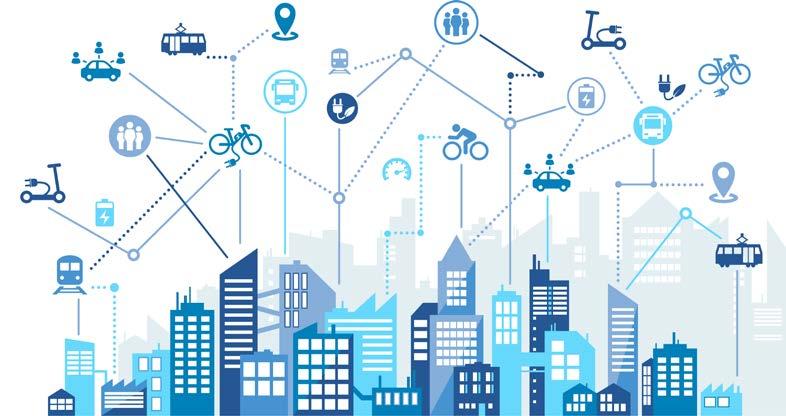
- School MM (art. 8.12bis of Decree Law no. 68 of 16 June 2022 - converted into Law 108/2022):
“Scholastic institutions, either networked or individually, shall appoint a school Mobility Manager from among the teaching staff, without exemption from teaching, or else shall appoint an external professional figure, in a manner consistent with the education plan. The school MM is responsible for:
• promoting a culture of sustainable mobility;
• promoting the use of cycling and pedestrian mobility, and rental and sharing services using electric or environmentally friendly vehicles;
• supporting the Area MM, if appointed, and the competent local administrations in the adoption of sustainable mobility measures, providing elements to facilitate the sustainability of travel for school staff and students;
• reporting any needs relating to school transport and the transport of persons with disabilities to the competent local entity.”
In collaboration with the Company MMs, the Area MM is tasked with preparing the Hometo-Work Travel Plan (HTWT), or rather a tool for planning the systematic home-to-work travel of employees, starting with those for each individual local work unit. To facilitate this task, Guidelines have been prepared, in which the indicators for monitoring are also laid out.
Excerpt from the Guidelines:
“It is necessary to collect all information and data on the staff mobility needs and to know the structural conditions of the company, the available means of transport in the area, and the resources available for the possible
implementation of measures to improve staff mobility. The information and analysis part of the HTWT must contain:
• Analysis of structural business conditions and available means of transport;
• Analysis of home-to-work travel” […]
“In order to establish a framework of the home-to-work travel for the company’s various locations, it is first necessary to categorise the employees based on residence and work schedule type. For the purpose of analysing the territorial distribution of the employees’ residences, the workforce can be broken down by “postal code”, or by “traffic zones”, based on the territorial zoning adopted by the mobility simulation models available from the municipal administration. With regard to work schedules, the personnel can be classified based on typical types of shifts: the reference parameters are working days and shift start and end times.
[...] In order to investigate the elements useful for understanding the employees’ travel habits and needs, as well as their willingness to change, the company mobility manager must also carry out a specific data collection campaign, using a questionnaire to be administered to each employee.”
The drafting of the HTWT thus entails a precise statistical survey phase of habitual mobility. The indications regarding the minimum necessary information to be collected are provided in Annex 3 to the Guidelines 4 , and provide detailed information on both the territorial localisation of the journeys, the means utilised (even in multi-modal combination) and the reasons for these choices, and the structure of the mobility behaviour (timetables, weekly frequency).
4. https://www.mit.gov.it/nfsmitgov/files/media/documentazione/2021-08/2021.08.03_Linee_guida_PSCL_-_finale.pdf

3.3 | OVERVIEW OF THE REGULATIONS FOR PASSENGER MOBILITY STATISTICS ON, WITH REFERENCE TO STATISTICAL PRODUCTION
An overview of the analysis of the regulatory sources mentioned in sections 3.1 and 3.2 is provided in the table below, in connection with existing or potential statistical production. Specific
Law 1085 of 31/10/1967
Regulations (EC) 437/2003 and 1358/2003
YES
1) Directive no. 2009/42/EC of the European Parliament and of the Council
2) EU REGULATION no. 1090/2010 of the European Parliament and of the Council
3) EU REGULATION no. 1239/2019
YES
Introduces the publication of a collection of statistical information regarding certain phenomena relating to transport and mobility among the institutional duties of the Ministry of Transport
These establish a sound statistical basis for the establishment of European Union (EU) air transport policies with comparable, consistent, synchronised and regular data, with common defining and methodological elements.
YES
1) Local public transport (MIT00018)
2) Maritime connections with the islands (PSN MIT-00024)
Air transport survey (PSN IST00145)
MIT in place
Production and dissemination of maritime transport statistics
Maritime Transport (PSN IST-00818)
ISTAT in place
ISTAT in place
Specific standards or guidelines
1) EC Regulation no. 91/2003
2) EU Regulation no. 2032/2016
3) EU Regulation no. 643/2018
Eurostat Guidelines on Passenger mobility statistics
YES
Common standards for the production of rail transport statistics at the EU level.
YES
Rail Transport (IST-01646)
ISTAT in place
1) DM MIT
397/2017
2) DM MIT
396/2019
3) Handbook for the drafting of the sustainable urban mobility plan (SUMP)
YES
EU-defined reference methodology for the harmonised statistical production of indicator sets on passenger mobility.
Regulations and guidelines for Sustainable Urban Mobility Plans (SUMPs): these indicate a series of actions for the preparation and monitoring of Sustainable Urban Mobility Plans (SUMPs).
Audimob - Survey of mobility styles and behaviour of residents in Italy (PSN IFT-0001)
1) 2-510 year monitoring of SUMPs
2) Environmental data collection in cities (PSN IST-00907)
ISFORT in place
1) Law 221/2015
2) DM MITE/MIT 179/2021
3) Law 108/2022
4) Guidelines for the drafting and implementation of home-to-work travel plans (HTWTs).
NO Establishment of the figure of the Mobility Manager and implementation and monitoring of Home-toWork Travel Plans (HTWT)
Periodic monitoring of HTWTs
Table 2 – Summary of regulatory sources related to statistical production
1) Metropolitan cities, municipal-ities and associ-ations of munic-ipalities with more than 100,000 inhab-itants (mandato-ry); Optional for other municipal-ities
2) ISTAT
Regional capitals, metropolitan cities, provincial capitals, and municipalities with populations of over 50,000 inhabitants
potential (partly in place)
potential (partly in place)
4 | MOBILITY DATA SOURCES IN ITALY
Giovanna Astori 1 , Mario Tartaglia 2[0000-0003-3216-8150]
1. ISTAT, Rome, Italy
2. FS Research Centre, Florence, Italy
4.1 | DATA FROM SURVEYS, FROM ADMINISTRATIVE SOURCES AND OTHER SOURCES
4.1.1 | MOBILITY BEHAVIOUR SURVEYS
Within the context of Italy’s national statistics system (SISTAN) there are ample and multi-faceted statistical indicators on mobility behaviour, which serve as a good starting point for building a broad information landscape to represent the phenomenon. However, none of the sources identified are exhaustive per se, and there are deviations from the definitions and methodological recommendations contained in the Eurostat Guidelines in many respects. The main characteristics and possible uses for each source are outlined below.
a. Audimob Observatory “Survey on mobility styles and behaviour of residents in Italy” (Isfort)
This is an annual survey primarily dedicated to the observation of the phenomenon of local and urban mobility. As of 2021, its reference methodology has been fully adapted to the Eurostat Guidelines. It includes:
- A reference population of residents 14-84 years of age;
- A quota sample of over 16,000 individuals, optimised with regard to the domains of gender, age and region of residence (with an oversampling for metropolitan cities);
- The observation of all journeys made on the day prior to the interview (covering both weekdays and holidays) through the completion of a log detailing each journey. The socio-economic characteristics of the respondent are also recorded, as well as information on the vehicles available to them;
- The main variables are: time, duration, length, origin, destination, motivation, means of travel utilised (detailed by modal stage), vehicle fuel source if a private car, and other accompanying persons during the journey;
- The survey technique is mixed: CATI (70%) CAWI (30%);
- Non-response is cancelled by replacing the units with quotas.
The indicators published in the Audimob report have an annual time reference and a national territorial reference. The available indicators are shown below for each domain variable:
- Classes of journey length (% distribution);
- Classes of daily journey frequency (% distribution, cluster criterion);
- Purpose of the journey (% distribution);
- Mode of transport utilised (% distribution, sustainable mobility rate);
- Time slots (% distribution);
- Systematic nature of the journeys (% distribution);
- Urban, extra-urban medium- or long-haul and total mobility (average distance, average time, % distribution of the journeys); also in combination: with socio-demographic segmentation (gender, age and occupational status); with territorial segmentation (geographical breakdown, demographic size of municipality); with purpose, time slot, systematic nature; with means of transport. (% distribution of the
journeys);
- Gender (Mobility rate %);
- Age groups (Mobility rate %);
- Occupational status (Mobility rate %);
- Geographical breakdown (Mobility rate %);
- Population size of the municipality of residence (Mobility rate %);
- Type of municipality (SNAI classification);
- Smart working in combination: with mobility behaviour (static/proximity/mobile); with purpose, time slot, systematic nature; with means of transport; (% distribution);
- Smart working (average number, length, and duration of the journeys).
As of 2019 (with a post-harmonisation of the 2019 and 2020 data and with the harmonised methodology as of 2021), all indicators foreseen in the Guidelines regarding local mobility have also been provided to Eurostat. For this set of indicators (see Chapter 3 “Guidelines and reference standards for mobility data collection ”) the territorial level is also that of the Country as a whole, with domain detail for local urban and total mobility. The time reference is annual.
b. TUS – Time Use Survey - Multipurpose (Istat).
From SiQual (Survey quality information system – Istat):
“The Time Use Survey is part of the “Multipurpose” household survey system. The main distinctive feature of this survey lies in the fact that, through the compilation of a log, it is possible to know how a 24 hour time period (divided into 10-minute intervals) is broken down by each respondent into miscellaneous daily activities, journeys, places visited, and accompanying people. This survey is considered strategic for obtaining knowledge of how the population organises their home lives from a gender perspective, as it allows for the study of the division of roles in society and families. For this reason, the survey is regu-
lated by Article 16 of Law no. 53 of 2000, “Official statistics on home life: ISTAT ensures a five-year information flow on the organisation of the population’s home lives through the Time Use Survey, breaking down the information by gender and age.”
The survey is conducted every five years. The basic register is the LAC/ANPR.
The PAPI technique is utilised (in part with a reading device, in part self-compiled). Experimental projects are active at the international level for the development of alternative data collection methods, namely involving the use of personal devices (Smartphone Apps, etc.). The field of observation covers the activities performed every day of the week (weekdays and holidays) for an entire calendar year (365 days of activity are observed, the sample is spread out over the entire year).
The questionnaire includes an initial section (A) of individual forms for each of the household members. Among other items, information is requested on the distance from school or work and the time taken to get there, on whether the person regularly participates in certain types of activities in their free time (volunteer work, sports, etc.); among the questions on biographical data, ample detail is requested on nationality and citizenship, even with regard to parents. There is also a general form for the family as a whole, which requests information on the availability of vehicles and their number by type.
Section B of the questionnaire is a daily log, where the respondent must describe (by filling out the fields on the form) all the activities performed (at 10-minute intervals) on a fixed day, from 4 a.m. onwards, for the entire 24 hour period. The information requested includes the means of transport used to travel (including changes of vehicles) and the purpose for the journeys; the possible presence of other persons is also requested for all activities (thus also for travel, which is considered a separate activity). Finally, any non-regular
journeys to other locations (domestic or foreign) during the observation period are also requested, as well as an indication of the distance travelled. The log must be completed for all family members, regardless of their age. There is also a section C on working time, which is not of interest with regard to the phenomenon of mobility.
The survey also records the occupational status, and whether it was completed on an ‘ordinary’ day, a holiday, illness, etc. (information useful for identifying recurrent mobility) and the condition determining the possible presence of a disability.
With regard to purposes, the processing of travel data is of particular interest for the topic of mobility. The logical scheme adopted in TUS coincides with that laid out in the Eurostat Guidelines, even with regard to the coding of the return journeys home.
The TUS survey can be seen as a useful comparison tool for mobility indicators on broad domains (e.g. mobility by purpose, by mode of transport, by age/gender). For the purpose of representing the mobility phenomenon, however, two factors are not relevant: the territorial reference of the journeys, and the distances travelled. It is therefore not possible to produce any specific information of a territorial nature (geographical or contextual) regarding the places where movements take place, except with regard to the territory of residence of the person making the journey.
Among the indicators published on an annual basis (the latest available are from 2013, with a new edition planned for 2023), those relating to activities classified as “Purpose-Driven Travel”, further broken down based on the reason for the travel, are of particular interest. The reference domains are as follows:
- The day of observation (average weekday/workday/Saturday/Sunday);
- Gender;
- Age class;
- Education level;
- Family size;
- Citizenship (Italian/foreign), only for the aggregated “Purpose-driven travel” mode;
- Working condition, only for the aggregated “Purpose-driven travel” mode;
- Marital status, only for the aggregated “Purpose-driven travel” mode;
- Position within the family, only for the aggregated “Purpose-driven travel” mode;
- Region, only for the aggregated “Purpose-driven travel” mode;
- Demographic size of the municipality, only for the aggregated “Purpose-driven travel” mode;
- Time slots, only for the aggregated “Purpose-driven travel” mode;
- Couple type, only for the aggregated “Purpose-driven travel” mode;
- Means of travel (in the TUS, this is considered a mode of the “places” variable, and is broken down into: walking/bicycle/ motorcycle, moped, scooter/private car/ other private vehicle other than car, and motorcycle/public transport), combined with gender, age, employment status, marital status, position in the household, region, and type of municipality.
The available indicators refer to the “time” variable, i.e.: generic and specific average duration (in hh:mm), time spent on the travel activity as a percentage of 24 hours, percentage incidence of people who performed the travel activity.
c. Permanent Population and Housing Census (Istat)
From the General Census Plan:
“The strategy of the Permanent Census is based on the combination of administrative data and data from sample statistical surveys, with the aim of producing information every year, and limiting the costs and the statistical burden on households. The methodological framework for the Permanent Census has the
primary goal of maintaining the high level of classification detail traditionally guaranteed by the Census conducted very ten years for a set of fundamental variables (demographic, social and economic), while at the same time increasing the temporal frequency of the information produced and the timeliness of its dissemination. The transition to a new Census model is made possible by the acquisition, processing, and statistical use of administrative sources which, through data validation processes, generate statistical registers that are updated at a high temporal frequency. The Permanent Census makes use of both the information produced by the statistical Registers that make up the Integrated Register System (IRS), as well as that collected through periodic surveys [...]. In particular, it will make use of two specific sample surveys: one Spatial (S) and one List-based (L). At the level of each municipality, the Permanent Census’ field of observation consists of the usual resident population [...]. The usual resident population includes persons of foreign citizenship legally residing in Italy. [...] Through the sample surveys carried out by Istat and integration with the SIR, the Permanent Census acquires information relating to the household structure, marital status, and demographic, socio/ economic, and territorial mobility characteristics of the usual residents.”
The List-based Survey, which is repeated annually, is aimed at acquiring any information of interest that cannot be deduced from the administrative records used to produce the Basic Register of Individuals (BRI). The L sample consists of 500,000 households. The reference register is the BRI. The survey technique involves an initial contact to engage with the sample unit, by means of a notice sent by mail. The subsequent data collection is based on two channels: CAWI on a dedicated Istat portal (with support from municipal survey centres) and in-bound CATI with a dedicated toll-free number. Non-re -
sponding units are contacted at a later stage with out-bound CATI and CAPI, in order to recuperate the missing responses.
Among others things, the thematic content includes detailed questions on nationality, professional status, and car ownership within the family.
The questionnaire includes a section concerning systematic travel for school and work, in which information is also requested regarding the spatial domain of the travel (with details at the municipal or generic foreign level), namely whether the journeys take place within the same municipality or elsewhere, and whether the reference for departure and return is the home within the municipality of usual residence or another accommodation (and its location at the municipal level); information is also requested regarding the travel times, and the means of transport utilised (up to three indications), in order of importance with respect to the distance travelled by mode. The classification of the transport modes is different from that proposed in the Eurostat Guidelines (and some items are missing, e.g. aeroplane), and the ‘walking’ mode is only considered as exclusive, not being included in the list.
The data on mobility for school and work purposes acquired with the Permanent Census are used to construct commuting matrices, with the O/D pairings broken down at the municipal level (currently available with update to 2011).
Within the commuting matrix, the variable Number of individuals is estimated based on the domains given by the intersection of the following variables:
- Record type S: Province of residence, Municipality of residence, Gender, Purpose of travel, Place of study or work, Usual province of study or work, Usual municipality of study or work, Foreign country of study or work.
- Record type L: Province of residence, Municipality of residence, Gender, Purpose of travel, Place of study or work, Usual
province of study or work, Usual municipality of study or work, Foreign country of study or work, Means of transport, Time of departure, Duration.
The indicators regarding mobility, which are published annually, refer to the following domains:
- Gender;
- Purpose (school/work);
- Commuting area (same municipality as usual residence/outside municipality of usual residence);
- Territory (all municipalities/provinces/ regions).
These indicators represent the size of the resident population that travels on a daily basis. The advantage of using this source mainly lies in the fact that it is a survey with a solid set-up and a very large sample, and it can certainly be considered a benchmark for comparing mobility indicators. For the purposes of knowledge requirements, the most significant gap concerns travel for reasons other than school or work.
d. ADL - Multipurpose Survey of Aspects of Daily Life (Istat).
Excerpt from the Methodological Note: “The ‘Aspects of Daily Life’ survey is part of the integrated system of Multipurpose Household Surveys launched in 1993, the aim of which is to produce information on individuals and households. When supplemented with information from administrative and business sources, the statistical information collected helps determine the information base for Italy’s social framework. Several subject areas are investigated through the survey, which are explored from an individual and family perspective. The information content can be grouped into four major areas: family, home and living area; health conditions and lifestyles; culture, social life and leisure activities; and interaction between citizens and services.” The survey is sample-based, the reference
register is the LAC/ANPR. The reference population includes all individuals (through the household sample unit), with no age restrictions.
The survey is conducted annually between the first and second quarter of the reference year. The technique is mixed (CAWI/CAPI-PAPI), with compilation with an interviewer being limited to non-respondents, who are contacted at a later data collection stage, and households without internet access. The CAWI is accessed through the dedicated Istat Portal, with personal login credentials. The survey model consists of a general form, with which all the socio-demographic information on the household and its members is collected, and specific sections (Family Questionnaire and Individual Questionnaire) by topic.
Among the aspects of daily life of households, the information regarding usual travel for school and work is recorded in a special section. The questions proposed in this section regarding travel are in part similar to those proposed in the Permanent Census model.
In particular, the classification of transport modes coincides, but the ADL survey offers the possibility of indicating more than three means of transport and, subsequently, the prevailing one in terms of distance travelled. It also includes a series of questions on the level of use and satisfaction with public transport, car and bike sharing services, and private vehicles.
The indicators produced refer to individuals who have travelled, and are of two types:
- Number of individuals;
- Percentage of the total number of persons with the same characteristics.
The output domains are given by the intersection of the following variables:
- Purpose (School/work);
- Gender;
- Age class;
- Mode of transport;
- Duration;
- Geographical breakdown;
- Region;
- Type of municipality (population size);
- Centre/periphery of metropolitan area.
e. Household expenditures – focus on Travel and holidays (Istat)
The information framework on the available sources would not be complete without an examination of the phenomenon of mobility over medium to long distances, the nature of which differs from that of local mobility in terms of both the indicators of interest and the appropriate survey techniques for observing and representing it. Surveys conducted in this area are generally retrospective.
With regard to this area of mobility, which generally concerns travel for work or personal reasons, the ‘Travel and Holidays’ focus within the survey household expenditures was identified as a current statistical source.
The survey collects data regarding ‘domestic’ and ‘outbound’ components of national tourism, or rather journeys made by Italian residents, both domestically and abroad.
The scope of observation includes journeys with short or long stays (more than three nights) and excursions (day trips with stays of at least three hours, without an overnight stay), made for personal and business reasons. Excursions to foreign countries are surveyed annually, while domestic ones are surveyed every three years. Information regarding overnight journeys is collected annually or every three years, depending on the variables. A complete overview of the phenomenon is thus obtained every three years.
For the purposes of this paper, this survey is not essential, as the information collected largely relates to the descriptive aspects of the stay or other factors linked to the tourism phenomenon and the relative expenditures; it only marginally concerns the aspect of travel in the sense of the transport to and from the destination, which is relevant to the study of mobility.
For each journey, the travel and excursion section of the questionnaire collects information on the destination (municipality or foreign country) and the relative purpose (work/ holidays/other reasons). Any habitual travel is also requested to be indicated. With regard to the variables necessary for the calculation of the indicators laid out in the Eurostat Guidelines, they are not included in the focus:
- The distance travelled to the destination (initial destination of the journey) and/or from the last location to return home;
- The duration of the travel to/from the main destination;
- The means of transport used for the initial travel (and/or the return). The focus requests that the predominant means of transport utilised be specified, but with reference to the travel event, which may not be the same as that used for the transport event (e.g. initial transport by plane, predominant use of hire cars during the journey);
- Presence of any other occupants in the private vehicle during the journey to/from the main destination.
The survey in question entails a high statistical burden on the respondent, also considering the fact that it refers to different entities of analysis (household expenditure – individual travel), and expanding it to also collect information on mobility would require the inclusion of a third entity, namely the transport event. Within the context of the road map for Trusted smart statistics at Istat, an experimental study was carried out regarding the use of telephone data for the estimation of the indicators for the “Travel and Holidays” survey.
f. Other sources from local entities. At the disaggregated territorial level (Regions, Metropolitan areas, and Municipalities), there have been numerous instances of research and production of mobility indicators, carried out either periodically or at irregular intervals. One prototype of these instances was the
smart survey carried out within the context of the HARMONY project funded with H2020 European funds, for which an application within the Urban Functional Area of Turin was used as a case study.
The survey is based on a quota sample of 584 individuals, stratified based on a zoning of the Turin UFA into eight areas (55% in four areas of the municipality, 33% in three areas of the metropolitan area, 12% in the other UFA municipalities), and then according to the following variables:
- Gender (equal parts M-F)
- Age (40% class 18-34, 60% class 35-64)
- Employment status (60% employed, 10% retired, 30% students)
- Number of cars owned within the household (25% no car, 50% one car, 25% two or more cars)
The sample was split over two observation periods, the first and second half of February 2022.
An App developed in Europe and tested in
other case studies was used for data collection (MobyApp).
The survey was organised in three stages:
i. Collection of preliminary and contextual variables on the individual and his or her mobility habits;
ii. Collection of individual travel information, qualified with the following variables: origin, destination, duration, mode of transport, purpose, through the MobyApp. This stage involves validation and integration of the data acquired independently by the App by the respondent;
iii. Questionnaire focusing on individual choices, based on the information gathered during the initial phase.
The respondent is asked to verify and validate the travel data for at least four days during the observation period.
The acquisition and retention of the individual data is carried out in anonymised form (ID assigned to each individual so as to keep their identity separate from the data collected).
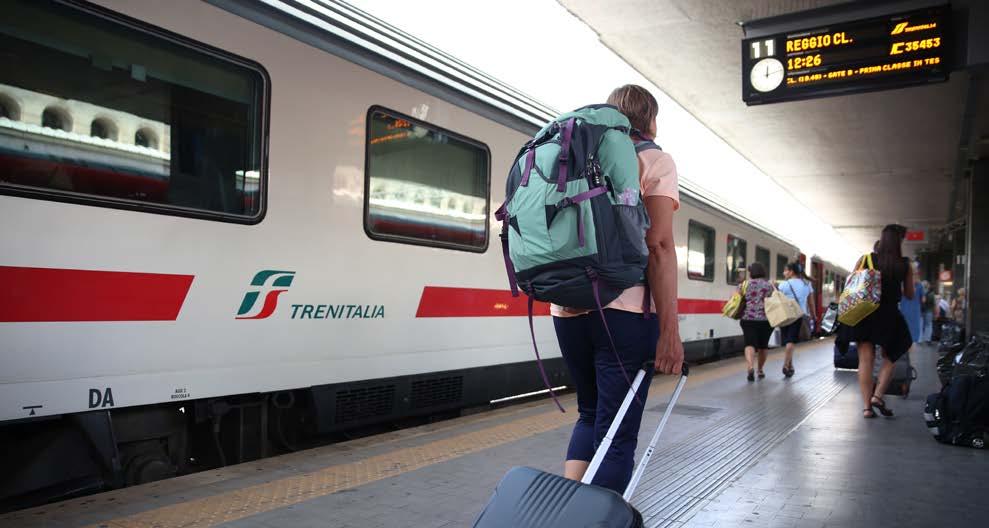
Overall, the experience was positive, especially in terms of the respondents’ liking of the technique utilised (App acquisition), and could serve as a starting point for further applications.
One information pool that should be monitored is that which could be generated starting with the Mobility Managers’ activities. The Ministries of Ecological Transition and Infrastructure and Transport have regulated the activities of Company, Scholastic, and Area Mobility Managers, whose main task is to establish Home-to-Work Travel Plans (HTWTs), with Interministerial Decree no. 179 of 12/5/2021 concerning the “Implementation of the provisions relating to the figure of the mobility manager,” as amended. Article 6 c.3c of the decree specifies that the activities of the Area MM include:
“the acquisition of data on the origin/destination and entry/exit times of employees and students provided by company and school mobility managers and the transfer of this
data to the municipal and regional public transport service planning bodies.”
The Decree also lays out the Guidelines for the drafting and implementation of HTWTs, which indicate the minimum information on home-study/work travel that the MM must collect in order to establish the plan, such as:
- Usual mode of travel;
- Use of only one means/mode of transport, to be specified;
- Combination of several means/modes of transport, to be specified;
- Distance travelled;
- Duration;
- Availability of means of transport, to be specified;
- Availability of transport service passes, to be specified.
The information underlying the establishment of the HTWTs could be used to represent habitual mobility at the urban and inter-municipal levels.
4.1.2 | MOBILITY SUPPLY AND DEMAND SOURCES
Another area of research and production, which expands on the framework of perspectives from which the mobility phenomenon is observed, is the representation of the supply of mobility infrastructure and services, and the demand for these services by users.
Among existing works, the following are of particular interest:
a. Survey of Environmental Data in Cities
- Urban mobility indicators (Istat)
The survey is conducted annually and collects environmental information on the 109 provincial/metropolitan municipalities, with the Municipality of Cesena being included since 2020 on a voluntary basis. The data and statistical information are aimed at providing an information framework to support the monitoring of the state of the urban environment, and the measures taken by local government
bodies to ensure good environmental quality in the cities. The survey consists of seven questionnaires - Air, Eco-management, Energy, Mobility, Waste, Noise and Urban Greenery. The Mobility section gathers information on the supply and demand of local public transport, sustainable mobility, and infomobility. The reference for the collection of the data, which are conveyed to Istat by the network of Provincial Capitals, is the UTP/SUMP. There is a section dedicated to shared mobility.
The territorial detail of the indicators produced is that of the Provincial Capitals.
For supply, the indicators are the following:
I. Density
II. Network length
III. Number of stops
Distinguished by:
- tram and metro networks;
- reserved lanes for LPT;
- bus and trolleybus stops;
- tram stops and metro stations;
- funicular railway, cable car and water transport stops or stations.
IV. Availability
V. Utilisation (number)
VI. Seats-km offered
Distinguished by:
- Buses and trolleybuses;
- Electric and natural gas or LPG powered buses;
- Tram cars and metro convoys;
- Funicular cars, cable car cabins, and water transport boats.
VII. Commercial speed of local public transport services
VIII. Active taxi licences
For demand, the indicators are the following:
I. Annual passengers per inhabitant
II. Annual local public transport passengers (absolute values)
For shared mobility and sustainable mobility, the published indicators are the following:
I. Presence of car sharing services
II. Availability of car sharing services vehicles
III. Vehicles used for car sharing services
Distinguished by:
- Car sharing;
- Bike sharing;
- Scooter sharing.
IV. Low-emission vehicles used for car sharing services (absolute values and per 100 vehicles)
V. Density and length of cycle paths
VI. Pedestrian areas
VII. Presence and variation of LTZs and 30 Zones
VIII. Presence of park-and-rides
IX. Number of parking spaces in the parkand-rides.
b. National Shared Mobility Observatory
The Observatory is a network made up of numerous public and private players involved in the development, dissemination, and supply of shared mobility services in Italy. It includes operators of shared mobility services, local authorities, research institutes, and associations. It is promoted by the Ministry of Ecological Transition, the Ministry of Infrastructure and Transport, and the Foundation for Sustainable Development.
It has produced the detailed Shared Mobility Report on the supply and demand of vehicle sharing and ride sharing (company carpooling) services on an annual basis since 2016.
The report offers a representation of the phenomenon at an aggregate level for the Italian territory, with focus on Rome and Milan. It also includes in-depth sections on the mobility behaviour and styles of the users of the services in question (clusters by mix of the means of transport utilised, both owned and shared).
The published indicators for the supply component, with an annual time reference, are the following:
I. Number of vehicles in the fleet
II. Ecological quality of the fleet (vehicle type and fuel type where present)
III. Presence and absence of services in the provincial capitals
The indicators for the demand component are the following:
I. Number of service registrations
II. Number of active services
III. Number of hires performed (by provincial Capital)
IV. Distances (km) (by provincial Capital)
V. Monthly and daily hires (Rome and Milan only)
The types of services are distinguished by:
- Free floating car sharing;
- Station based car sharing;
- Free floating bike sharing;
- Station based bike sharing;
- Scooter sharing;
- Push scooter sharing;
- Ride sharing.
For some indicators, the Bike, Scooter and Push Scooter modes are further classified into a single group called Micromobility, as opposed to Car-Sharing.
Within the context of the Observatory’s activities, a pilot survey on urban mobility (Progetto Pollicino – “The Thumbelina Project”) was conducted in the Municipality of Bologna. The purpose of this survey was to collect information on all the travel carried out by the individuals falling within the sample, either using their own means or using shared mobility services.
From the Observatory’s website: “The project’s first field of application was in the city of Bologna, where 2,400 citizens downloaded the IoPollicino app to their phones and consented to the geolocation of their smartphones. A total of about one thousand were involved in the survey, and entered certain essential information, such as the means of transport they utilised and the reasons for their travel, for at least seven days. Of these, six hundred “Thumbelinas”, broken down by age and gender, formed a representative sample of mobility in the city and an outstanding database for analysing people’s mobility behaviour, habits, and styles. The data was collected voluntarily, completely anonymously, and without any form of profiling or scoring (i.e. methods that attribute
a positive or negative score to certain citizen behaviours). In fact, the aim of the analysis was to advance the research on urban mobility behaviour with respect to the traditional sample surveys carried out with telephone or web-based interviews, which, as a general rule, only collect data referring to a single working day of the week, thus not allowing for an analysis of individuals’ mobility on each day of the week, from the time they leave the home until they return.”
It is a smart survey, in which the data is collected via a mobile device App (IoPollicino), and is suitably processed to be rendered anonymous. The app collects the devices’ locations at regular intervals via GPS (so-called bread crumbs). The users must complete the picture of the mobility activities carried out by providing information on other aspects, such as the purpose of the individual journeys. They can also correct the information acquired via GPS if they find any inaccuracies in the reconstruction of their movements (regarding the structure of the movements, the vehicle utilised, etc.). The App-based collection technique makes it possible to record all the journeys made, including those of less than one kilometre, which are relevant in urban areas and are generally excluded from traditional surveys.
Like that illustrated in section 4.1.1, letter f, within the context of the HARMONY project, this initiative could also serve as a prototype experience for a larger-scale smart survey.
4.1.3 | DATA FLOWS BY MODE OF TRANSPORT
Another group includes the consolidated official surveys subject to European regulation that organise transport-related information from a “silo” perspective, or rather distinguishing between the acquisition of data and the production of indicators based on mode of transport.
Limiting the scope of reference to passenger mobility (therefore excluding elements related to the transport of goods), the most relevant methodological aspects can be summarised as follows:
a. Maritime transport (Istat)
The maritime transport survey provides statistics on the transport of goods and passengers for commercial purposes. It consists of a census-type survey of arrivals and departures from Italian ports. The passenger data are displayed for ports that handled at least 200,000 passengers.
The sets of indicators produced by Istat and Eurostat are as follows:
- Annual number of passengers carried (excluding cruise passengers), by flow type (international, domestic, total) and direction (inbound, outbound, total);
- Annual number of passengers Embarked/Disembarked, for the top 20 European ports;
- Annual number of passengers Arriving (disembarked) and Departing (embarked) from all Italian ports, by direction (arrival/departure);
- Embarked/disembarked/Total for NUTS2;
- Quarterly number of passengers transported by all main ports (excluding cruise passengers), by flow type (national, international) and direction (arriving, departing, total);
- Quarterly number of passengers transported by port (Italian), flag, direction (inbound, outbound, total).
The survey does not provide for the preparation of an O/D matrix.
Eurostat estimates several indicators for passenger-km (Pkm), published in the Database table titled “Annual maritime passenger transport in the Exclusive Economic Zones (EEZs) of European countries (domestic, international intra-EU27, international extra-EU27, transit, total) per country.”
Within the context of the road map for Trusted Smart Statistics within Istat, an experimental study is underway for the use of AIS data to increase the data quality of the maritime transport survey.
b. Air transport (Istat)
The new statistical survey on air transport is comprehensive, and collects information on the transport of passengers, freight and mail, including flight stages, available seats, and aircraft movements. The survey units are the airports, and the data are provided by the airport management companies. The quarterly data refer to airports that submit the data on a monthly basis.
The indicators produced by Istat and Eurostat (using Istat and Enac data) are as follows:
- Total passengers (monthly, quarterly, yearly);
- Passengers carried, by route (monthly, quarterly);
- NUTS2 passengers (annual);
- Total passenger-kms (annual);
- National + EU passenger-kms (annual);
- Non-EU passenger-kms (annual);
- Flyover passenger-kms (annual).
The O/D matrix of passengers by country pairs (passengers on board and passengers carried) is available.
c. Rail transport (Istat)
The purpose of the rail transport survey is to collect statistical information on the transport
service provided by railway undertakings operating in Italy, in compliance with the provisions of the Regulation of the European Parliament and of the Council no. 643/2018 (which recast all previous legal acts relating to rail transport statistics). The survey is of a census type, and the survey unit is the active railway undertaking, or rather any public or private sector undertaking providing freight and/or passenger transport services by rail. This survey collects data, in varying degrees of detail, on freight and passenger transport, as well as on accidents occurring on the national and local rail network, and on the technical characteristics of the national network infrastructure.
The sets of indicators published by Istat and Eurostat are as follows:
- Total passengers carried, annually and quarterly;
- Annual number of passengers transported by flow type and direction (domestic, international inbound and outbound);
- Annual international passenger transport from border to country of disembarkation;
- Annual international passenger transport from country of embarkation to border;
- Annual number of passengers carried by train speed (up until 2011);
- Average annual distance in km per passenger (domestic/international);
- Total passenger-kms, annual and quarterly;
- Annual passenger-kms by flow type and direction (domestic/international inbound and outbound).
The O/D matrix of passengers transported is also available, with NUTS2 territorial detail, issued every five years.
d. Road passenger transport (Eurostat)
Eurostat regularly publishes a table showing annual country-level estimates for the following indicators:
- Passengers and Passenger-km transported by buses and coaches registered in Italy, broken down into national/national urban/national intercity transport.
Data for international transport is not available for Italy.
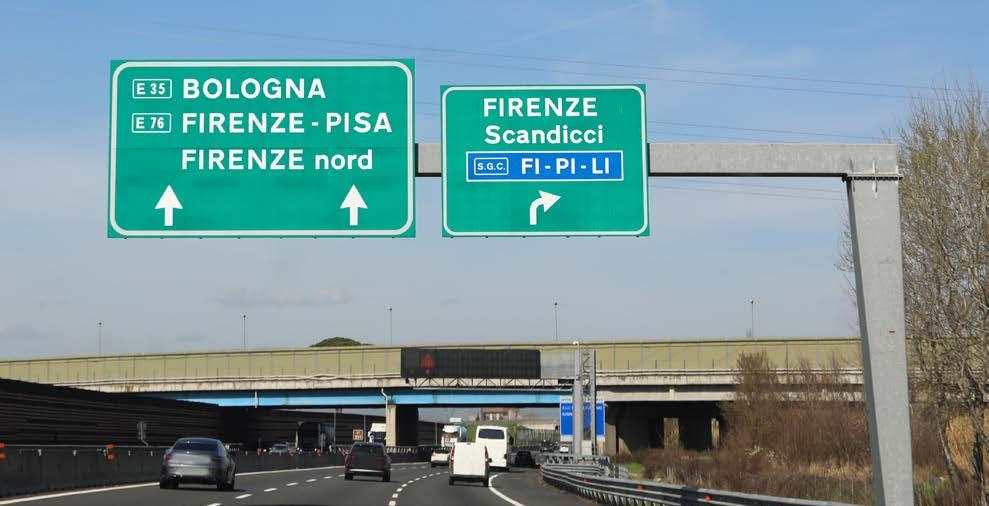
4.1.4 | VEHICLE TRAFFIC
The projects for estimating vehicle traffic have grown significantly in recent years, both at the international level, where Eurostat/ITF/UNECE have prepared a detailed table for the acquisition of vehicle-km indicators for various
M1: Passenger cars - Total.
▪ Petrol
▪ Diesel
▪ Pure electric
▪ Petrol-Hybrid
▪ Diesel-Hybrid
▪ Other fuel - Total
of which :
- Bi-fuel petrol/LPG
- Bi-fuel petrol/CNG
- LPG
- CNG
- Flex fuel
- Other
M2: Mini buses - Total.
▪ Petrol
▪ Diesel
▪ Pure electric
▪ Other fuel
M3: Buses and coaches - Total.
▪ Diesel
▪ Diesel-Hybrid
▪ Pure electric
▪ CNG
▪ Other fuel
N1: Goods vehicles uo to 3.5t - Total.
▪ Petrol
▪ Diesel
▪ Other fuel - Total
of which :
- Bi-fuel Petrol/LPG
- Bi-fuel Petrol/CNG
- Pure electric
N2: Goods vehicles between 3.5t and 12t - Total.
▪ Diesel
▪ Other fuel
N3: Goods vehicles over 12t - Total.
▪ Diesel
▪ Other fuel
L1/L2/L6: Mopeds and light 3- and 4-wheelers - Total.
▪ Petrol
▪ Pure electric
▪ Other fuel
L3/L4/L5/L7: Motorcycles (with or without sidecar), tricycles and quads - Total.
▪ Petrol
▪ Pure electric
▪ Other fuel
T5: Tractor on wheels - Total.
▪ Diesel
▪ Other fuel
road vehicle categories (Odometer reading questionnaire, figure 2) and at the national level, with the study of recent and consolidated data collections.
The most relevant sources are listed below.
a. AISCAT data on motorway vehicle traffic.
The monthly indicators are the vehicle-km broken down by:
- Motorway companies (both associated and outside the AISCAT);
- Vehicle type (light “motorbikes and two-axle motor vehicles with a ground clearance, at the front axle, of less than 1.30 m”, heavy “two-axle motor vehicles with a ground clearance, at the front axle, of more than 1.30 m, and all motor vehicles with three or more axles.”).
The quarterly indicators are the vehicle-km broken down by:
- Motorway or tunnel;
- Vehicle type (light/heavy).
The data are estimated based on motorway entries and the length of the road.
b. ANAS data on vehicle traffic on the extra-urban roads under its jurisdiction.
From the ANAS website:
“The automatic statistical traffic detection system, consisting of approximately 1,200 counting sections, is distributed throughout the entire Anas network: all the sensors transmit their data to a centralised monitoring system, called PANAMA (Anas Platform for Monitoring and Analysis), which verifies and processes the trends of the Detected Mobility Index. The reliability of the acquired data is ensured by a series of control processes; in particular, two automatic control steps guarantee the consistency and coherence of the
database. The first process aims to highlight any problems within the file transmitted by the local survey station. Any consistency errors encountered as a result of these checks, which cannot be corrected, render the file unusable, and it is therefore rejected by the system.
Once the data are loaded into the database, the PANAMA platform performs the second step, which consists of various procedures for assessing the reliability of the aggregated data, not by eliminating the data entered, but by classifying them using a parameter that verifies their consistency with respect to certain real situations that can actually occur. This parameter makes it possible to exclude uncertain data from the values used to calculate the desired measurements. The veracity of the acquired data, or rather the sensors’ ability to detect the actual traffic passing through that section, is also assessed by Anas personnel by carrying out spot checks. The Anas personnel use a technology that allows for the acquisition of videos of the vehicles actually passing through the section, with the simultaneous superimposition of the string of data recorded by the local control unit. The film is then viewed in the office, at which time all the counting and classification errors are detected, and the quality of the returned data is automatically assessed with respect to the reality of the situation on the road.
“[For the sensor network] There are basically two technologies utilised: inductive loops and microwave sensors, although the system currently also receives traffic data from the Vergilius system for electronic average speed

monitoring. Additional technologies have also been implemented, such as dynamic weighbridges, cameras for detecting hazardous goods, and bluetooth trackers for time tracking.”
The data are collected by ‘counting sections,’ which, in turn, are classified by territory (Italy, North, Central, South, Sicily, and Sardinia), and by vehicle types, divided into:
- light vehicles, which include motorbikes, cars with and without trailers, and vans or trucks (with profiles corresponding to types with a load capacity of less than 3.5 t), also with and without trailers;
- heavy vehicles, including all other vehicles, or rather “large” lorries (with profiles corresponding to types with a load capacity of more than 3.5 t), road trains, articulated lorries, and coaches.
The indicators produced on a monthly basis are the “Detected Mobility Indices” (DMI), which correspond to the estimated average number of vehicles detected by the sensors for each domain, defined by:
- vehicle type (total/heavy);
- territorial area (Italy, North, Central, South, Sicily, and Sardinia);
- day of the week (total/workday/pre-holiday/holiday);
- time slot (day 6am-10pm/night 10pm6am).
The “Annual Average Daily Traffic” (AADT) is also published, calculated as the average of the passes in each direction at each station, for all “valid days”, or rather the days of the year when passes are detected without
malfunctions, and if at least 98% of the passes detected in the 288 five-minute intervals into which the day is divided are loaded. This indicator is published for the following domains:
- Location (road, km);
- Municipality;
- Province;
- Vehicle type (light/heavy).
Finally, ANAS produces quarterly and annual reports, available upon request, on the traffic detected by the individual stations. This information is collected in an accurate fashion, according to a scheme that summarises vehicle passages with two indicators (average volumes and average speeds) based on the following aspects’ domains of intersection:
- Flow direction (ascending/descending);
- Vehicle type (light/heavy);
- Time slot (6am-8pm/8pm-10pm/10pm6am).
Finally, data elaborations regarding specific territorial and temporal scopes can be obtained by submitting a request to ANAS.
c. Istat project “Quantification and description of vehicle traffic”
The aim of the project is to estimate the traffic, in terms of vehicle-km, carried out by vehicles of all categories registered in Italy, starting with the data contained in the Overhaul Archive and the vehicle fleet, provided by the Ministry of Transport and the Automobile Club d’Italia (ACI). The estimates will be carried out on an annual basis. They are currently not yet available, as the project remains in the development phase with regard to a number of essential methodological aspects.

4.2 |
COMPLEMENTARY SOURCES TO COMPLETE THE KNOWLEDGE FRAMEWORK
4.2.1 |
COMPLEMENTARY SOURCES FOR THE ESTABLISHMENT AND DEVELOPMENT OF TRANSPORT MODELS
Within the context of the production of national statistics, in addition to the sources discussed in the previous section, it has also been deemed appropriate to highlight a number of additional findings and elaborations, which provide a valid support for the establishment of the transport models. Although they will not be examined in detail here, a non-exhaustive list may be useful to complete the overall picture.
a. Vehicle fleet. Holder ACI (PSN ACI00002). Objective: to provide a detailed picture in Italy, by analysing the data of the vehicles registered with the Public Vehicle Register.
b. The car market: first registrations, cancellations, and vehicle transfers. Holder ACI (PSN ACI-00014). Objective: To complete the car market analysis by describing the main characteristics of the used car market, first registrations, and cancellations.
c. Registrations and transfers of ownership. Holder MIT (PSN MIT-00010). Objective: To consolidate and improve the production of statistical information in support of the knowledge and decisions of policy makers, economic operators, and citizens.
d. Valid driver’s licences and new drivers. Holder MIT (PSN MIT-00011). Objective: To consolidate and improve the production of statistical information in support of the knowledge and decisions of policy makers, economic operators, and citizens.
e. Local public transport. Holder MIT (PSN MIT-00018). Objective: dissemination of statistics on local public transport.
f. Inland waterway transport. Holder MIT (PSN MIT-00021). Objective: dissemination of statistics on inland waterway transport.
g. Maritime connections with the islands. Holder MIT (PSN MIT-00024). Objective: dissemination of statistics on maritime connections with the islands.
h. Household expenditure survey. Holder ISTAT (PSN IST-02396). Objective: The household expenditure survey records the expenditures incurred by households residing in Italy to purchase goods and services for family consumption, and is the source of information for the description, analysis, and interpretation of spending behaviour. The transport expenditures section is broken down (with additional subclasses) into: expenditures for the purchase of transport equipment, for the purchase of transport services, for the operation of transport equipment.
4.2.2 | COMPLEMENTARY SOURCES FOR MONITORING AND EVALUATING POLICIES AND OBJECTIVES
As outlined thus far, mobility is a strategic aspect of the socio-economic fabric of every country, as it constitutes both the cause and the effect of the smooth and resilient functioning of the gears connecting the systems in which businesses, households, and institutions operate.
The measurement of the phenomenon, from different perspectives and with types of indicators, can therefore be found in numerous statistical collections, which use information from existing official sources.
For these purposes, it is worth mentioning a few of particular importance, in order to complete the framework of the information needs and potential that could be assisted with the use of Big Data.
a. The Sustainable Development Goals (SDGs).
From the Istat website:
“On 25 September 2015, the United Nations General Assembly adopted the 2030 Agenda for Sustainable Development, in which it outlines the guidelines for activities over the next 15 years. The 17 Sustainable Development Goals that make up the 2030 Agenda constitute the global action plan to eradicate poverty, to protect the planet, and to ensure prosperity for all.
The Sustainable Development Goals refer to various domains of development relating to environmental, social, economic and institutional issues, laying out a global action plan for the next 15 years. The way forward at the international level is laid out by the Cape Town Global Action Plan: the strategy for taking all the actions necessary to modernise and strengthen the statistical systems at both the national and global levels.
In order to identify a shared statistical information framework, as a tool for monitoring and evaluating progress towards the achieve -
ment of the Agenda’s goals, the United Nations Statistical Commission established the Inter Agency Expert Group on SDG Indicators, which established a set of over 200 indicators.”
The indicators established by the Expert Group are supplemented with additional indicators for the national context (i.e. specific to each country adopting them). For the topic of Transport and mobility, the sections concerned are 3 “Health and well-being” (with regard to road accidents), 9 “Business, innovation, infrastructure,” 11 “Sustainable cities and communities,” and 13 “Combating climate change.”
Istat publishes its SDG Report annually, and an updated dashboard with data and graphs is also available, where the specific indicators can be consulted.
b. Report on equitable and sustainable well-being (BES)
From the Istat website: “The project to measure equitable and sustainable well-being aims to evaluate the progress of society not only from an economic, but also from a social and environmental point of view.
Istat, together with representatives of the third sector and civil society, has developed a multidimensional approach to measure “equitable and sustainable well-being” (Bes), in order to complement the indicators related to production and economic activity with measures of the key aspects of well-being, together with measures of inequality and sustainability. 12 basic domains were identified to measure well-being in Italy.
The detailed analysis of indicators published annually in the Bes Report as from 2013 aims at raising awareness of the Country’s strengths and difficulties. To improve the quality of life of citizens the concept of well-being should
be considered as starting point for public policies and individual choices.
In 2016, “Equitable and sustainable well-being” has become part of the economic planning: the Economic and Financial Document (Def) has to include an analysis of recent trends for selected indicators and an impact assessment of proposed policies. Moreover, a monitoring report of the indicators and the outcomes of the assessments is presented to the Parliament every year in February.”
The indicators of interest for the topic of mobility are included in the domain “12 – Quality of services,” and are derived from ISTAT surveys.
Every year, Istat publishes a descriptive report on Italy’s situation with respect to the various thematic domains, and provides an updated dashboard complete with tables and graphs.
c. National Recovery and Resilience Plan (NRRP)
From the website of the Italian Government’s Presidency of the Council of Ministers: “The National Recovery and Resilience Plan (NRRP) Italy Tomorrow, approved by the European Commission on 22 April 2021, is part of the Next Generation EU (NGEU) programme
[…] The Plan is made up of six Missions and has three main objectives. The first is short term in nature and refers to repairing the economic and social damage caused by the pandemic crisis.
Secondly, from a more medium/long-term point of view, the Plan tackles a number of weaknesses that have been weighing down on Italy’s economy and society for decades: the long-standing divides between the country’s geographical areas, gender inequality, weak productivity growth and a low rate of investment in human and physical capital.
Lastly, the Plan’s resources will go towards
driving a comprehensive ecological transition.
[...] Established at the Presidency of the Council of Ministers, the Steering Committee is the political guidance body that coordinates and drives the implementation of the NRRP interventions.
[...] Each Steering Committee meeting provides an opportunity to take stock of the progress of the reforms and investments. They also ensure the timely identification of any obstacles and bottlenecks, so that prompt action can be taken and the scheduled commitments agreed upon with the Commission can be met, which are decisive for the allocation of funds.”
The missions that most directly affect the areas of transport infrastructure and mobility are M1 “Digitalisation, innovation, competitiveness, culture and tourism,” M2 “Green revolution and ecological transition,” and M3 “Infrastructure for sustainable mobility,” even with regard to the digital transformation (MaaS services, public transport service monitoring, etc.).
d. Collections of indicators at the international level.
Numerous data collections have been implemented over time for the monitoring and representation of mobility by international institutions with different institutional duties. One example is the Common Questionnaire UNECE/ITF/Eurostat, the completion of which requires a large collection of indicators on an annual basis, ranging from performance by mode of transport, to road accident statistics, and existing infrastructure.
The NSP envisages a specific work activity (IST-02653) to provide the indicators for these collections: “Processing of national and regional data on transport, environment, and tourism for international institutions (Ocde-itf, Eurostat, Unece, Unwto).”
4.3 | REFERENCE SOURCES FOR INFRASTRUCTURE AND SERVICE REPRESENTATION
Statistical production and the development of transport models require precise geospatial references with as much detail as possible. As indicated in chapter 2 “Definitions ”:, these references can be of various types, and can differ in the case of data acquired by traditional methods and Big Data.
In order to create a representation of the potentially available infrastructures and services with which mobility is carried out, we have a number of sources at our disposal, of which those mainly utilised at present are indicated.
- The National Transport Survey provides general information on transport infrastructure broken down into different chapters by type, such as Chapter V “Road Transport”, which indicates the extent of the road network by type of road (Motorways, Regional and Provincial Roads, Other Roads of National Interest) at the national and regional levels (Appendix to Chapter V).
- Rail network (source: RFI - Rete Ferroviaria Italiana), map with details railway lines by type and stations;
- Road/motorway network (sources: ANAS, AISCAT), maps with details by road type, with indications of the motorway toll stations;
- Register of Italian ports (source: MITMinistry of Infrastructure and Transport), a detailed and georeferenced list of the 351 main Italian ports;
- Airports in Italy (source: ENAC – National Civil Aviation Authority), map detailing the traffic basins of the Italian airports;
- Data on the transport services offered. In order to complete the picture of the potential offered by the territory to meet the mobility demand, the added value of the sources that provide the spatio-temporal references of the services offered, or rather the timetables for rail, airport, port and long-distance road transport, and the General Transit Feed Specification (GTFS) for local public transport and rail, have been highlighted. Such sources, although strategic for model building, are not always accessible or available throughout the territory.
The aforementioned infrastructure data are available in graphical format (shapefiles for GIS) or accompanied by information that allow for georeferencing; some can be downloaded from institutional websites like the Ministry of Infrastructure and Transport’s Open Data site 5. In addition, in view of European Directive 2007/2/EC (INSPIRE), implemented by Legislative Decree of 27 January 2010 and aimed at establishing a European data infrastructure for the sharing of spatial data related to environmental policies among the various member states’ public sector organisations, transport network data should be made available and shared on the INSPIRE platform6. With regard to GTFS data, on the other hand, some are freely available, as in the case of the Region of Tuscany, which renders all of the GTFS data for its regional public services7, or any that may be provided by service operators, available upon request for study or research purposes.
5. https://dati.mit.gov.it/catalog/dataset
6. https://inspire.ec.europa.eu/
7. https://dati.toscana.it/it/dataset/rt-oraritb
4.5 | SUMMARY OF THE MAIN STATISTICAL SURVEYS
Survey
Audimob Observatory
Time Use Survey-Multipurpose (TUS)
Author ISFORT ISTAT
Survey technique CAWI/CATI PAPI
Frequency Annual
Every five years
Uniform EUROSTAT Yes Yes
Geographical spatial reference
Municipality of origin-> Municipality of destination
However, two factors are not relevant for the purposes of representing the mobility phenomenon: the territorial reference of the journeys, and the distances travelled
Mode of travel
Combination of means utilised
Frequency Yes
Reason Yes
Socio-economic
Temporal extent
Original name (ITA)
Means of travel (in the TUS, this is considered a mode of the “places” variable, and is broken down into walking/bicycle/motorcycle, moped, scooter/ private car/other private vehicle other than car, and motorcycle/public transport), combined with gender, age, employment status, marital status, position in the household, region, and type of municipality.
Yes, for some indicators
Average weekday (public holiday)
Osservatorio Audimob Indagine sull’uso del tempo-Multiscopo (TUS)
Table 3 – Summary of the characteristics of the main statistical surveys on passenger mobility
Permanent Population and housing census
Multipurpose Aspects of Daily Life (ADL) Survey
Household expendituresFocus Travel and Holidays
ISTAT ISTAT ISTAT
CAWI/CATI/CAPI
CAWI/CAPI-PAPI CAPI
500,000 households about 25,000 households spread over about 800 Italian municipalities about 32,000 households residing in approximately 540 Italian municipalities. Annual
Transport mode classification other than Eurostat
-Travel occurs within the same municipality or elsewhere, the departure and return reference is the habitual place of residence.
-Municipality of Origin --> Municipality of Destination
Up to 3 vehicles in order of distance travelled per mode
Region, geographical breakdown
Annual and ongoing throughout every month of the year
The region and geographical breakdown of residence and the region and province, EU foreign country, or non-EU geographical macro-area of the journey’s main destination is recorded
Yes
Possibility of indicating more than 3 means, and then the main one utilised in relation to the distance travelled
Prevalent means of transport used within the context of the journey, which may not coincide with that used for the initial/return journey
Any habitual travel is also requested to be indicated
Work/school Work/school Work/ Holidays/ other reasons
Yes
Average weekday
Censimento permanente della Popolazione e delle abitazioni
Gender/age group
Yes
Indagine Multiscopo Aspetti della Vita Quotidiana (AVQ)
Spese delle famiglie -
5 | ANALYSIS OF SEVERAL CASE STUDIES ON PASSENGER MOBILITY
Lorenzo Vannacci2[0000-0001-9587-7611] , Martina Farsi2[0000-0002-3132-8071], Giovanna Astori 1
1. ISTAT, Rome, Italy
2. FS Research Centre, Florence, Italy
5.1 | ANALYSIS OF THE LIMITATIONS OF THE CURRENT DATA SOURCES FOR PASSENGER MOBILITY
“Good decision making requires good data and good models, especially for transport planning. This, in turn, requires good data to establish the model base year, a sound representation of travel choice behaviour by users in its formulations and a good estimation of how the future will evolve. Data collection is therefore essential, but it is often perceived by modellers as an endless source of frustration.”
[5.1]
Transport modellers are often confronted with snapshots of the mobility phenomenon that are missing certain portions; in addition to the construction of the models themselves, the main activity consists of the joint interpretation of data of different natures, in order to form a general picture. Time and economic resources are generally limited; interviews of any kind, whether by telephone, online, or in person (i.e. conducted by intercepting the users of the transport system at key points in the network, e.g. on the main access roads to the study area), take time to plan and execute, and have a significant economic cost. The data from the ISTAT census are an indispensable source, as they allow us to obtain a territorial breakdown of the census sections, but are currently only available up to 2011. In this case, the missing piece is occasional mobility; this component, which has become increasingly significant in recent years, must therefore be assessed through other data sources. The Audimob mobility survey, in which travel reasons are investigated, is extremely important for this
purpose; another major difference between the two types of surveys is the output type: the indicators derived from the ISTAT census represent the individuals engaged in the travel, whereas the Audimob survey represents the structure of the journeys themselves, which is determined by the main purpose for which the individual started the travel (e.g. the home to work commute, with a stop for refuelling, is considered as a single journey for ‘work’ purposes, without interruptions). Then again, the Audimob sample is rather small compared to the census sample, consisting of just 16,000 interviews as opposed to the approximately 500,000 households involved in the census survey.
Other information that helps provide an overview of the mobility situation is the data collected by transport infrastructure managers and public transport service operators. In terms of road infrastructure, data are available from the traffic flow survey system for the roads managed by ANAS, which has numerous survey points located throughout the country (see Chapter 4 below, entitled “Mobility data sources in Italy”); even the Regions (e.g. Tuscany and Emilia Romagna) and the Metropolitan Cities themselves sometimes have their own systems of traffic count points on their own roads, which, like the ANAS data, can be obtained for a fee, or even free of charge by submitting a justified request. This type of data provides precise information regarding the georeferencing of the survey location, quantifying the travel flow

